The post Use These TV Picture Settings for ‘House of the Dragon’ Episode 5 first appeared on Joggingvideo.com.
]]>
Calling all Game of Thrones fans watching House of The Dragon on HBO: Your TV might benefit from a tune-up. The prequel series is streaming now in glorious 4K HDR, with the fifth episode available starting tonight. So far the show has looked visually stunning, although you may have found certain scenes too dark on your TV.
That’s no coincidence. House of the Dragon cinematographer Fabien Wagner also directed numerous GoT episodes, and when viewers complained that scenes looked too dark, Wagner blamed the TVs. “A lot of the problem is that a lot of people don’t know how to tune their TVs properly,” Wagner said in a 2019 interview. This year Wagner also posted a House of the Dragon trailer to his Instagram with the caption “…and it’s not too dark!!!!!! Even when you watch it on your iPhone in broad daylight 😳🤘.”
Wagner may be (ahem) throwing shade, but either way I’m willing to bet that some viewers will find parts of House of the Dragon too murky on their TVs. As CNET’s TV reviewer I’ve watched my share of dark — er, “cinematic” — scenes and I can tell you he’s right about one thing: An improperly adjusted TV can ruin the experience.
To help prevent that from happening to you as you enjoy House of the Dragon, check out my tips below, which were updated from but very similar to my original advice for Game of Thrones.
Watch Game of Thrones and House of the Dragon on HBO Max
See at HBO Max
Turn off the lights
Like pretty much anything on a big screen, House of the Dragon looks best when the room is dark and full of characters.
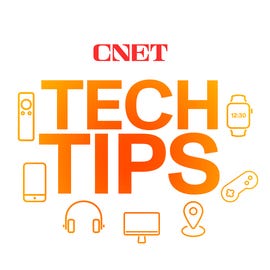

Turning off the lighting in your room is one of the best ways to improve the picture. Any light reflecting off the screen can make dark scenes harder to see and even wash out bright scenes. Try to watch at night, or at least draw the curtains, and turn off as many lights as you can. If you must have some light in the room, it should ideally be in a position behind the TV so it doesn’t hit the screen directly, and turned down as dim as possible. Bias lighting is your friend.
Read more: Get Rid of Annoying TV Glare With These 5 Tricks
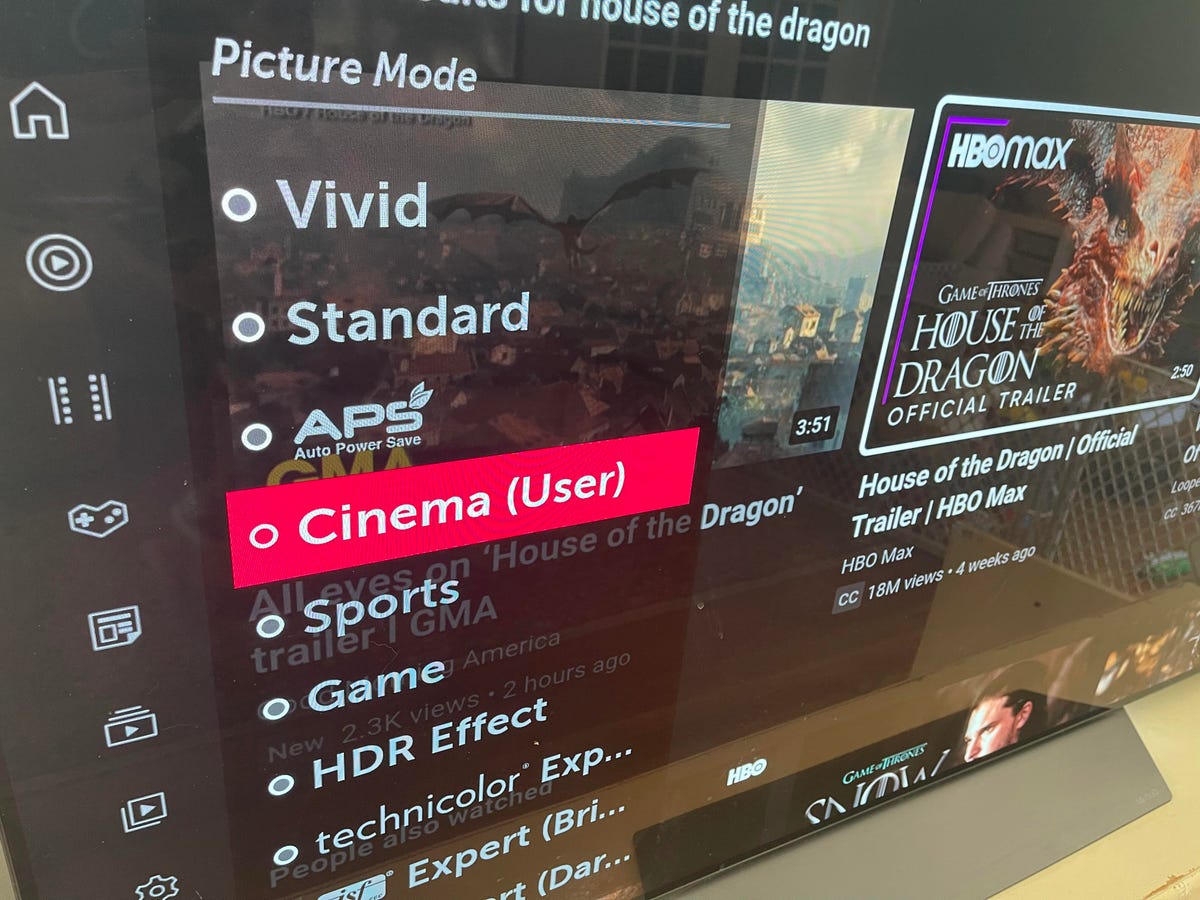

Choosing a mode like Movie of Cinema is the easiest way to get an accurate picture.
David Katzmaier/CNET
Choose the Movie, Cinema or Calibrated picture mode
All TVs have picture modes that affect nearly every aspect of the image: brightness, color, gamma, black level and image processing, among other things.
Sound complex? Relax, you don’t necessarily have to adjust any of that stuff individually to get peak picture quality. The most accurate picture mode on any TV is almost always the one called Cinema (on LG), Custom (Sony), Movie (Samsung, TCL) or Calibrated Dark (Vizio). Simply choosing it will get your TV most of the way toward looking its best in a dark room. If your TV has a Filmmaker mode, that’s a great choice, too.
Compared to modes such as Standard or Vivid, Movie modes can initially look duller and less impactful at first. But in almost every case, they’ll show the most realistic color and be tuned for dim rooms — which generally means lower light output, solid contrast and correct shadow detail. Movie mode isn’t for everyone, so feel free to cycle through the other modes, too. Some of the best TVs have brighter modes that are still accurate.
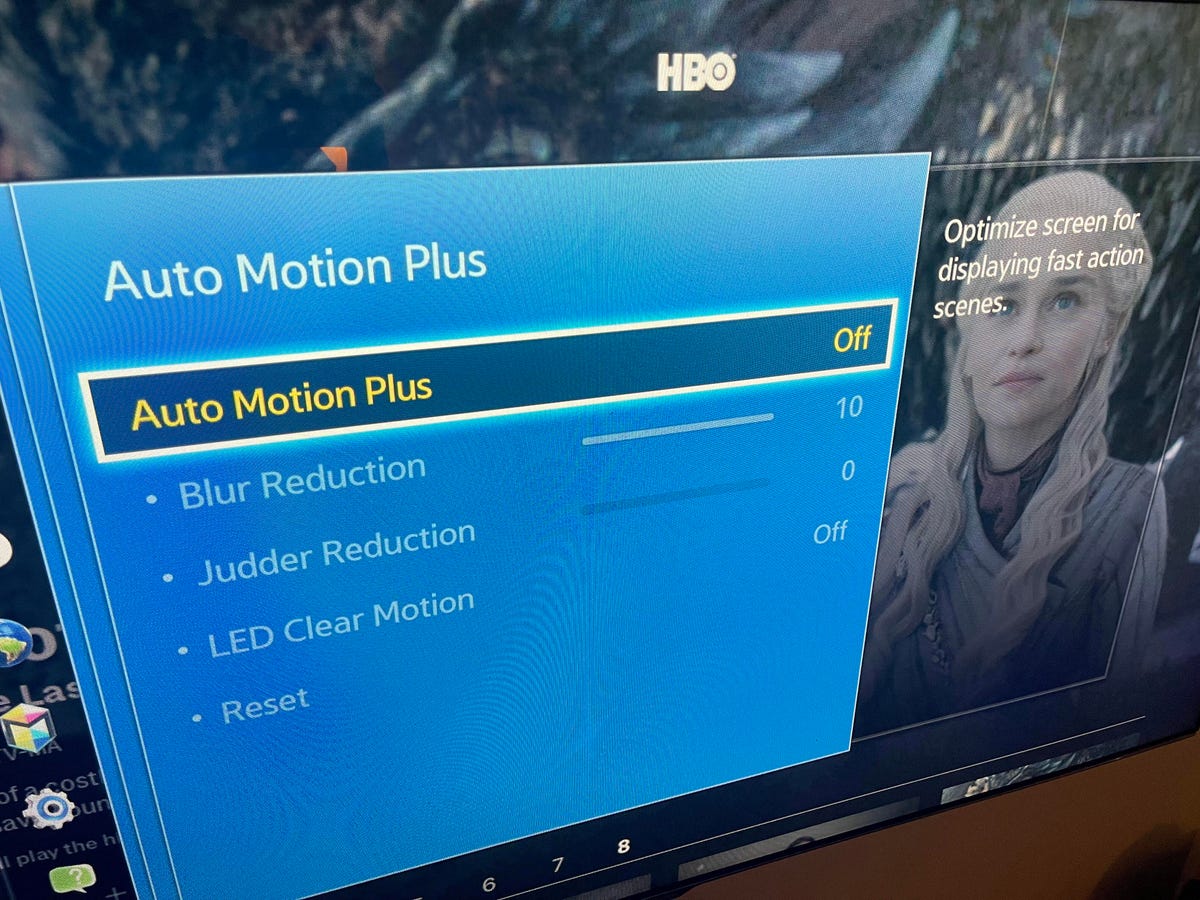

Many TVs have a smoothing setting, such as Auto Motion Plus on the older Samsung TV seen here, that control smoothing, aka the soap opera effect. Turn it off.
David Katzmaier/CNET
Turn off the soap opera effect
On many TVs, Movie modes will keep one of the least cinematic effects intact: the soap opera effect, which introduces smoothing that makes motion look buttery and less filmlike. You’ll want to turn it off to preserve the 24-frame cadence of House of the Dragon (and lots of other stuff). If you don’t believe me, take Tom Cruise’s word for it.
Not every TV has the video processing that causes the soap opera effect, so if yours doesn’t, you’re in the clear. But most higher-end models do, as do plenty of popular midrange TVs like the TCL 6-Series. And unfortunately, each manufacturer buries it deep in the TV settings menu and calls it something different. LG calls it “TruMotion,” Samsung “Auto Motion Plus” or “Picture Clarity,” TCL “Action smoothing,” Sony “MotionFlow” and Vizio “Motion Control.” Here’s how to find it and turn it off.
Other settings to try
Feeling adventurous? Your TV has myriad other settings to play around with, and many have esoteric names and functions. Adjusting any of those settings may or may not improve the image to your eye, and adjusting them using one scene for reference could make other scenes look worse.
Happily, every picture mode has a “reset” function you can use if you go too far and mess something up. Here’s a few settings and what they do.
Backlight: This adjusts your LCD TV’s light output. For dark rooms you’ll generally want it low, because having it too high can wash out the image. Note that some TVs call the backlight setting “Brightness” or, on OLED TVs, “OLED Light.”
Brightness: This adjusts the brightness of “black” and shadow detail. Increasing it can make dark areas like the backgrounds in The Battle of Winterfell more visible, but going too high can, again, wash out the image.
Contrast: This controls bright details, and setting it too high can render them invisible. It’s usually best to leave it alone.
Color and Tint: Two more that, at least in Movie modes, are usually best left alone. If anything you might want to move color a hair up or down if the image doesn’t look saturated enough (or too saturated), but doing so in one scene can ruin another.
Gamma: There’s usually a couple of settings here, all of which affect how dark areas look. We recommend starting with 2.2.
Local dimming: If you have an LCD TV with this feature (usually called something annoying like “Xtreme Black Engine Plus” or “Local contrast”) you’ll want it turned on to increase contrast and improve black levels. In most TVs I’ve reviewed, the lowest local dimming setting looks best, but feel free to cycle through the options.
What about compression artifacts?
Many of the complaints around Game of Thrones mentioned bands along the edges of light as the army of the dead advances, big blocks of darker color as the Dothraki horde recedes into the night and other issues. These same issues might crop up during House of the Dragon, too.
Unfortunately these issues usually aren’t the TV’s fault, so they’re harder to correct. Most are caused by video compression, the technology used to deliver video streams to your TV, and often there’s nothing you can do. At least not until the Blu-ray comes out. You still have a Blu-ray player, right?
In some cases you can adjust out these issues by making scenes darker, by reducing the brightness control, for example. The noise-reduction controls on your TV might help a little.
The issue might be your streaming bandwidth. Try reconnecting the device’s Wi-Fi or connecting to your router by wire if possible. The bandwidth coming into your home might be a problem too. If you can wait a bit, try watching later, when fewer viewers will be streaming in your neighborhood or nationwide. Here’s some more tips for improving streaming.
No matter what TV you have, a few tweaks can usually make the image a little better, whether you’re watching House of the Dragon, Game of Thrones or any other cinematic TV show or movie.
The post Use These TV Picture Settings for ‘House of the Dragon’ Episode 5 first appeared on Joggingvideo.com.
]]>The post Best TV for 2022: Top 10 Smart TVs From Budget to High first appeared on Joggingvideo.com.
]]>Fall is the time for new TVs to shine. Between sports like NFL football and MLB baseball and new streaming TV shows like House of the Dragon and The Rings of Power, you have lots of excuses to invest in a new screen. Fall is also the time when TV prices start coming down, like so many autumn leaves, in advance of the holiday season. Our list, featuring TVs we’ve reviewed reviewed side by side, is designed to help you find the best TV for you, from high-end OLEDs to budget LCDs and everything in between.
One important tip: Consider a 2021 model first. New 2022 TVs are on store shelves and online retailers now, promising enhancements like better picture quality, more features and future-proof HDMI connections. But last year’s TVs are still available, too, and for the most part they’re just as good and much better deals. We’ve included an “Outlook” section for non-2022 TVs below to tell you about the newer models, where applicable.
Now, on to our picks.
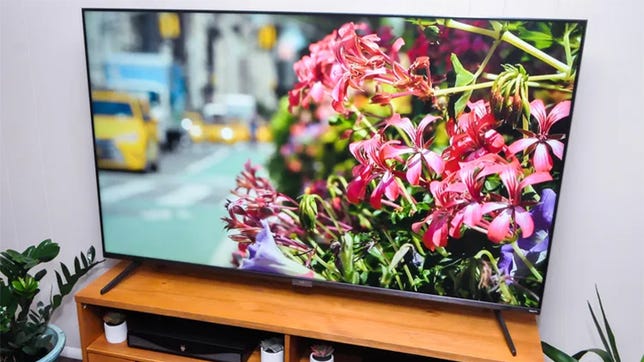

David Katzmaier/CNET
TCL 6-Series Roku TV
Best TV for the money
Nov 2020
No TV we’ve ever tested offers this much picture quality for as little cash. The TCL 6-Series Dolby Vision HDR TV has an excellent image thanks to mini-LED tech and well-implemented full-array local dimming that helps it run circles around just about any other TV at this price. It’s also a solid choice for gamers, with a THX mode that combines low input lag and high contrast. As if that’s not enough, the Roku TV operating system is our hands-down favorite.
This TV first came out in 2020 but is still a current model and remains our top choice. TCL also sells an 8K version of the 6-Series, but we don’t think it’s worth the extra money, as well as a Google-powered version we have yet to review (although according to TCL its image quality is the same as this Roku version).
Sizes: 55-, 65-, 75-inch (The prices shown below are for the 65-inch size.)
Outlook: The replacement for this TV is the TCL R655 series. We haven’t reviewed it yet, but according to TCL it should be brighter than this model with more local dimming zones, as well as offering 144Hz input capability for gaming and an improved stand design. Pricing between the two series is similar, with the exception of the 75-inch size which is more expensive in the newer model.
Read our TCL 6-Series (2020 Roku TV) review.
$1,000 at Amazon$1,000 at Best BuyGet Price AlertsYou’re receiving price alerts for TCL 6-Series Roku TV
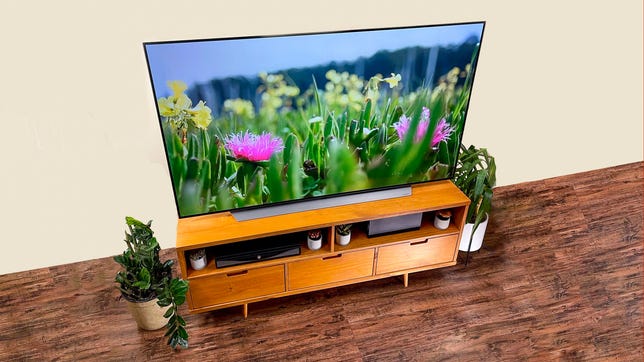

David Katzmaier/CNET
LG OLED C1
Best high-end TV for the money
Nov 2021
With picture quality as good as any TV we’ve ever tested and a price that’s not too crazy, the LG C1 OLED TV is still our go-to pick for people who prioritize picture quality and are willing to pay for it. It beats any non-OLED TV on this list, including the Samsung QN90A below, with its perfect black levels, unbeatable contrast and superb off-angle viewing. It also has the best gaming features, making it the perfect companion to an Xbox Series X or S, PlayStation 5 or both. The C1 comes in a wide variety of sizes as well, although the bigger models are really expensive.
We also reviewed the successor to the C1, the LG C2, and the two have essentially identical picture quality. The newer version brings a couple of minor improvements, including lighter weight and a 42-inch size. Since the 2021 C1 currently remains on sale for hundreds less than the 2022 C2, we recommend getting the C1 instead.
Sizes: 48-, 55-, 65-, 77-, 83-inch. (The prices shown below are for the 65-inch size.)
Read our LG C1 series OLED TV review.
$2,200 at Target$2,097 at AmazonGet Price Alerts$2,200 at Best BuyYou’re receiving price alerts for LG OLED C1


TCL 4-Series
Best cheap TV
Roku is our favorite platform for live TV streaming services like Netflix, Hulu and Amazon Prime Video, and it’s even better baked into the TV. This TCL 4-Series can’t beat the models above on image quality — its 4K resolution and HDR performance don’t do much to help the picture — but it’s perfectly fine for most people, especially at this price.
We haven’t reviewed the latest version of this TV, the TCL S455 series, but it has similar specifications and we expect it to perform basically the same as the earlier model we did review.
Note that TCL also makes a Google TV and an Android TV version of the 4-Series. We haven’t reviewed them, but we expect similar picture quality to the Roku version.
Sizes: 43-, 50-, 55-, 65-, 75-, 85-inch. (The prices shown below are for the 50-inch size.)
$320 at Target$280 at Best BuyGet Price Alerts$280 at AmazonYou’re receiving price alerts for TCL 4-Series
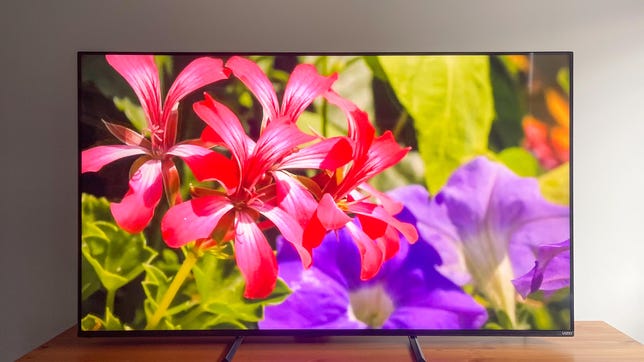

David Katzmaier/CNET
Vizio MQX
Best picture for tighter budgets
The Vizio MQX is one of the least expensive TVs to feature full-array local dimming, which lets it reproduce TV shows, movies and games with enough contrast and pop to do HDR justice. The MQX has fewer dimming zones than more expensive TVs like the TCL 6-Series, but it offers 16 zones on the 50-inch, 30 on the 65-inch and 42 on the 75-inch, which is more than enough for excellent overall picture quality, with bright highlights, dark black levels, punchy contrast and accurate color.
Unlike the M7 last year, the MQX has a true 120Hz refresh rate, which allows compatibility with 4K/120Hz signals from game consoles like the Xbox Series X and PlayStation 5, and worked well in our tests. Vizio supports both major HDR formats, HDR10 and Dolby Vision, in the M-Series. If you can’t save up for the TCL 6-Series but want a better picture than the 4-Series, the Vizio MQX is an excellent happy medium.
Sizes: 50-, 65-, 75-inch. (The prices shown below are for the 65-inch size.)
$850 at Best BuyGet Price AlertsYou’re receiving price alerts for Vizio MQX
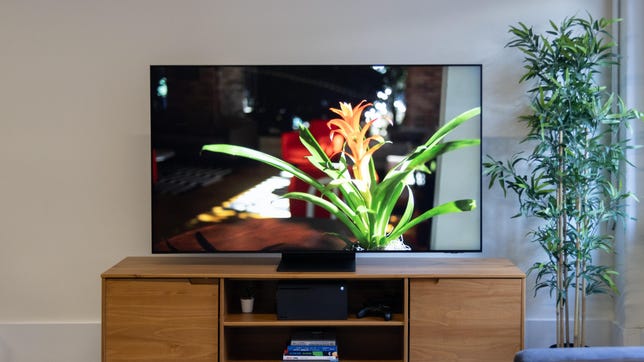

Bobby Oliver/CNET
Samsung QN90B
Best high-end TV that’s not an OLED
Looking for a high-end TV with spectacular image quality, but don’t want an OLED? The Samsung QN90B is your best bet. This TV uses QLED TV tech augmented by mini-LED for a brighter image than any OLED TV. The spectacular contrast of OLED still won out in our side-by-side tests, but the QN90B QLED screen comes closer than ever.
In summer 2022 the older version of this TV, the QN90A, remains on sale for hundreds less. It’s also an excellent performer but it’s slightly dimmer than the QN90B. It also lacks some of the 2022 model’s features, including the new game hub with cloud gaming.
Sizes: 43-, 50-, 55-, 65-, 75-, 85-inch. (The prices shown below are for the 65-inch size.)
Read our Samsung QN90B review.
$1,900 at Samsung$1,798 at AmazonGet Price Alerts$1,900 at Best BuyYou’re receiving price alerts for Samsung QN90B
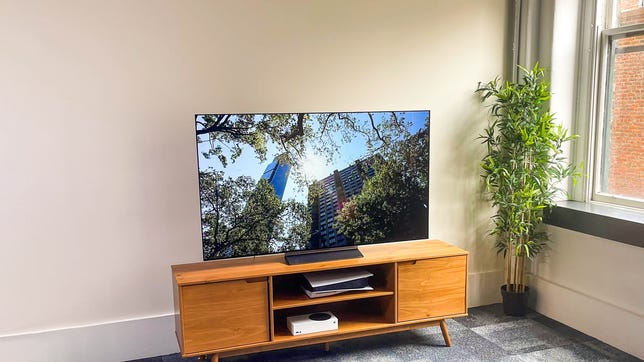

David Katzmaier/CNET
LG OLED C2
Best high-end 2022 TV
The C2 is superb but right now the 2021 model is a better deal. We compared the C2 directly to last year’s C1, side by side. In terms of picture quality, the two were basically identical, despite the fact that LG touts the new “Evo” panel on the C2. Real improvements include carbon-fiber construction for up to 47% lighter weight — the 65-inch version we reviewed weighs just 37 pounds with its stand, compared to 72 pounds for the 65-inch C1 — as well as some additional tweaks to game mode and a new “always ready” feature. Those enhancements aren’t worth the price difference, so our advice is to buy a C1 now or wait until later this fall, when we expect the C1 to sell out and the C2 to get a price cut.
The C2 is also available in a 42-inch size, while the smallest C1 is a 48-inch model.
Sizes: 42-, 48-, 55-, 65-, 77-, 83-inch. (The prices shown below are for the 65-inch size.)
Read our LG C2 series OLED TV review.
$2,300 at Target$1,897 at AmazonGet Price Alerts$1,900 at Best BuyYou’re receiving price alerts for LG OLED C2
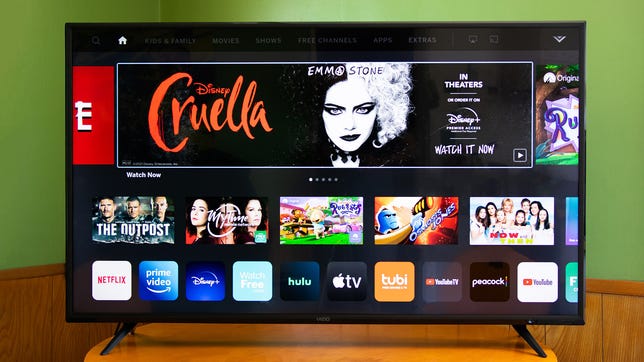

Geoffrey Morrison/CNET
Vizio V-Series
Best cheap TV runner-up
Vizio’s V-Series is our favorite budget alternative to the TCL 4-Series Roku TV. We liked Roku’s smart TV system better (sound familiar?), but the V-Series has some advantages, including a better remote with voice and more advanced picture settings. Picture quality between the two was basically the same, so if you don’t have a preference, it makes sense to get the cheapest one.
Sizes: 43-, 50-, 55-, 58- 65-, 75-inch. (The prices shown below are for the 55-inch size.)
Outlook: The 2022 version of the V-Series has very similar specifications and pricing as the 2021 series. We haven’t reviewed it yet but we expect the two to perform about the same.
Read the Vizio V-Series (2021) review.
$370 at Target$473 at AmazonGet Price Alerts$371 at Best BuyYou’re receiving price alerts for Vizio V-Series
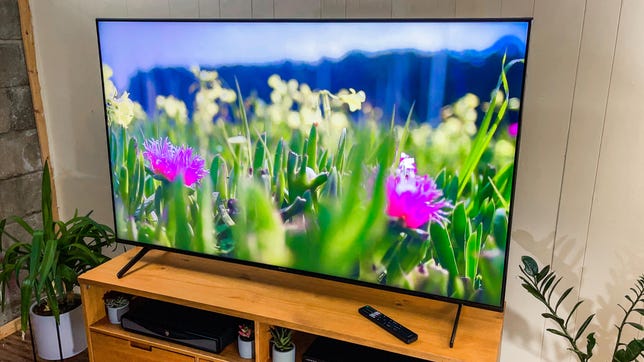

David Katzmaier/CNET
Sony X90J
Best midpriced alternative to TCL, Vizio
With excellent picture quality, anchored by full-array local dimming and plenty of brightness to make HDR content shine, the X90J is Sony’s answer to the TCL 6-Series and step-up Vizio models. This LED TV’s sleek looks and the Google TV operating system score additional points, as does its next-gen console support — including variable refresh rate (VRR), enabled by a software update in March 2022 — and built-in NextGen TV tuner. This Sony TV is perfect for PS5 gaming and works with Alexa & Google Assistant. If you want an “S” brand, this is one of the best values we’ve tested.
Sizes: 50-inch, 55-inch, 65-inch, 75-inch. (The prices shown below are for the 65-inch size.)
Outlook: The successor to the X90J is the X90K. We haven’t reviewed the new model yet but its image quality specifications are largely similar to the 2021 version, so we don’t expect many picture quality differences. Unlike the 2021 version, the new model ships with VRR enabled out of the box.
Read our Sony X90J series (2021) review.
$1,500 at Best Buy$1,180 at eBayGet Price AlertsYou’re receiving price alerts for Sony X90J
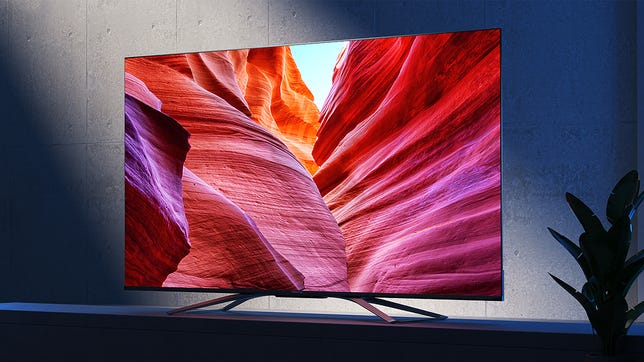

David Katzmaier/CNET
Hisense U8G
Maximum brightness for the money
Most of the TVs on this list are bright enough for just about any room, but maybe you want a screen that’s as bright as possible. The U8G outshines others in its price range and was basically as bright as the significantly more expensive Samsung QN90A. Its image quality falls a bit short in other areas and its selection of sizes is limited, but if raw brightness is what you crave, the U8G delivers.
Sizes: 55-, 65-inch. (The prices shown below are for the 55-inch size.)
Outlook: The successor to the Hisense U8G is the U8H. The new version uses a mini-LED backlight and could improve the image quality of the 2021 model, but we haven’t reviewed it yet so we can’t say for sure. Unlike the 2021 U8G, the 2022 U8H includes an ATSC 3.0 tuner.
Read our Hisense U8G series review.
$700 at Amazon$713 at Best BuyGet Price AlertsYou’re receiving price alerts for Hisense U8G
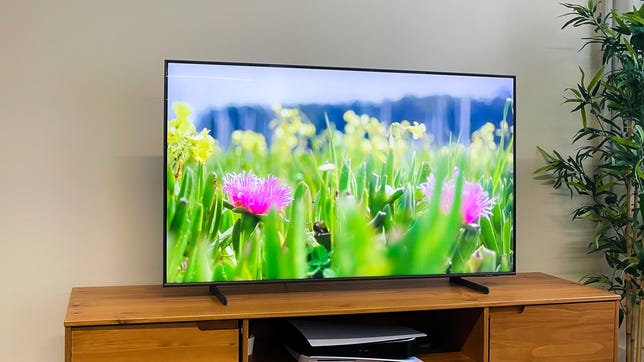

James Martin/CNET
Samsung Q60B
Best design in a midprice TV
Samsung is the brand that sells more TVs than anyone, and one of its most popular is the Q60 series. Its sleek QLED screen design stands out compared with the other TVs on this list — even though the ultrathin OLED models are sleeker — and it offers better features, image quality and more sizes than models like the TCL 4-Series and Sony X80K. The TVs listed in this article are all superior values, but if you want a Samsung TV and can’t afford the QN90A, this is a great choice.
Note that the 2021 version, the Q60A, is still on sale and can be cheaper than the Q60B in some sizes. The newer version measured brighter in our tests, but if you want the best deal, stick with the Q60A if it’s still available.
Sizes: 43-, 50-, 55-, 60- 65-, 70- 75-, 85-inch. (The prices shown below are for the 55-inch size.)
$700 at Best Buy$698 at CrutchfieldGet Price Alerts$698 at AmazonYou’re receiving price alerts for Samsung Q60B
Other TVs we’ve tested
Sony KD-X80K series: Sony is a prominent brand and its higher-end TVs like the X90J do well in reviews, but the entry-level TV in its 2022 lineup, the X80K, didn’t make the list. It costs around the same as the TCL 6-Series and Samsung Q60 TVs, and had a worse picture than both, with lighter black levels and contrast. It’s definitely not a bad TV, and we liked its Google smart TV system, color accuracy and connectivity, but you can definitely do better for the money. Read our Sony KD-X80K series review.
Toshiba Amazon Fire TV C350 series: One of many Fire TVs available for sale, this one is typical of the breed: so-so image quality and a smart TV system that lags behind Roku and Google TV. If you’re a big fan of Alexa voice or see this TV at a really low price it might be worthwhile, but otherwise go for the TCL 4-Series. Read our Toshiba Amazon Fire TV C350 series review.
LG OLED G1 series: The G1 is an excellent overall TV, but compared to the C1 and C2, we don’t think it’s worth the extra money. Image quality is basically the same as those two models, so you just end up paying extra for its ultrathin, wall-hugging “gallery” design. On the other hand if that price difference is small enough — sometimes a G1 will cost only $100 more than a C1, for example — it might be worthwhile for you. Note that this TV’s successor, the 2022 LG G2, promises a brighter picture, but we haven’t reviewed it yet so we can’t say for sure. Read our LG OLED G1 series review.
How does CNET test TVs?
Our TV reviews follow a rigorous, unbiased evaluation process honed over nearly two decades of TV reviews. Our primary TV test lab has specialized equipment for measuring light and color, including a Konica Minolta CS-2000 spectroradiometer, a Murideo Sig-G 4K HDR signal generator and an AVPro Connect 8×8 4K HDR distribution matrix. We use Portrait Displays CalMan Ultimate software to evaluate every TV we review. In every CNET TV review, three or more similar TVs are compared side by side in various lighting conditions playing different media, including movies, TV shows and games, across a variety of test categories, from color to video processing to gaming to HDR. Our reviews also account for design, features, smart TV performance, HDMI input and gaming compatibility and other factors.
Read more: How We Test TVs
TV FAQs
We’ll post the answers to commonly asked TV questions below. If you have any others, feel free to reach out on Twitter (@dkatzmaier), or by clicking the little envelope icon on my CNET profile page. Doing so will let you send a message straight to my inbox.
How much should I spend on a TV?
Prices vary widely by size and features, from less than $100 for basic 24-inch TVs to more than $2,000 for big OLED models. TVs last a long time, however, so we think it’s worthwhile to spend a little extra beyond the bare minimum to get a bigger screen, better picture quality or better features. With that in mind, here’s some ballpark prices that will get you a very good TV in 2022.
- 55-inch: $700
- 66-inch: $1,000
- 75-inch: $1,300
You could pay (much) more or less. The fact is just about any TV will produce a picture decent enough to satisfy most viewers. Most complaints you read in user reviews aren’t about picture quality. Instead they’re about ease of use, smart TV menus or sound (or a broken TV).
What size TV should I buy?
In our opinion bigger is better, and your money is best spent on large screen sizes rather than a slight upgrade in image quality. The answer also depends on room size and seating distance: If you have a big room and sit farther away, you’ll want a bigger TV.
Which is better, OLED or LED?
In our reviews, OLED TVs, which use organic light-emitting diode technology, have always had better picture quality than LED TVs, which are basically LCD TVs that use LED backlights. The main reason is that OLED TVs can produce a perfectly dark shade of black with no stray illumination of blooming, which leads to better contrast and pop. LED TVs can get brighter, however, and usually cost less than OLED TVs.
What is the best smart TV system for streaming?
At CNET our favorite is Roku for its simplicity, but different systems like Google TV, Amazon Fire TV, Samsung and LG have different strengths, in particular for voice commands. In any case, we don’t consider the built-in smart TV system that important because you can always connect a streaming device to any TV.
How do I get the best TV sound?
Most TVs sound terrible, because their thin cabinets don’t have room for decent-size speakers or bass. If you want to get good sound you should buy an external audio system. Even an inexpensive soundbar will deliver much better audio quality than a TV’s built-in speakers.
More home entertainment recommendations
- Buying a New TV in 2022
- Best Soundbars for 2022
- Best Streaming Device in 2022
- Best TV Antennas for Cord Cutters, Starting at Just $10
- Dolby Atmos: Why It’s Cool, How It Works and How to Get It
- Best Sonos Speakers Starting at $100
- QLED vs. OLED: Which TV Tech Should You Buy?
- HDR Formats like Dolby Vision, HDR10, Technicolor and HLG Explained
- Best TVs for Gaming
- Best 75-Inch TVs for 2022
The post Best TV for 2022: Top 10 Smart TVs From Budget to High first appeared on Joggingvideo.com.
]]>The post Roku Update Adds Continue Watching, Save List, Bluetooth Private Listening first appeared on Joggingvideo.com.
]]>
Roku owners, get ready to check out some new features. The company’s newest free software upgrade, version 11.5, is rolling out to Roku TVs and Roku streaming players “in the coming months,” according to Roku. It brings a few new extras without upsetting the company’s familiar, app-based menus.
The company makes some of CNET’s favorite streaming devices and TVs, which we’ve lauded for their simplicity and affordability. The $40 Roku Express 4K Plus is our favorite streaming device overall, for example. Another thing we like about Roku is the company’s regular cadence of free software upgrades, which have added features such as password dictation and photo screensavers to existing devices.
Potentially the most useful feature in 11.5 is Continue Watching, which allows you to resume TV shows and movies where you left off. It works with HBO Max, Netflix, Paramount Plus and The Roku Channel to start, with additional streaming services coming later.
Most apps, including Netflix, HBO Max and others, already offer similar functionality with the apps themselves, while Roku’s biggest competitors, Fire TV, Google TV and Apple TV, also feature Continue Watching prominently on their home pages. Roku’s version is more difficult to find, however, because it’s buried in the What to Watch section one level down from Roku’s main home page.


Now playing:
Watch this:
7 Tips to Get More Out of Your Roku TV
8:04
Another new addition to the What to Watch section is a Save List, which lets you mark content you want to watch later.
Roku is also adding a new section to its home page menu entitled The Buzz, which seems like a mashup of social media and entertainment. The streamer bills it as a “frequently updated collection of posts” featuring clips, trailers and interviews that users can “like,” save to watch later, or start streaming. Launch partners include AMC Plus, Apple TV Plus, Showtime, Starz and more.
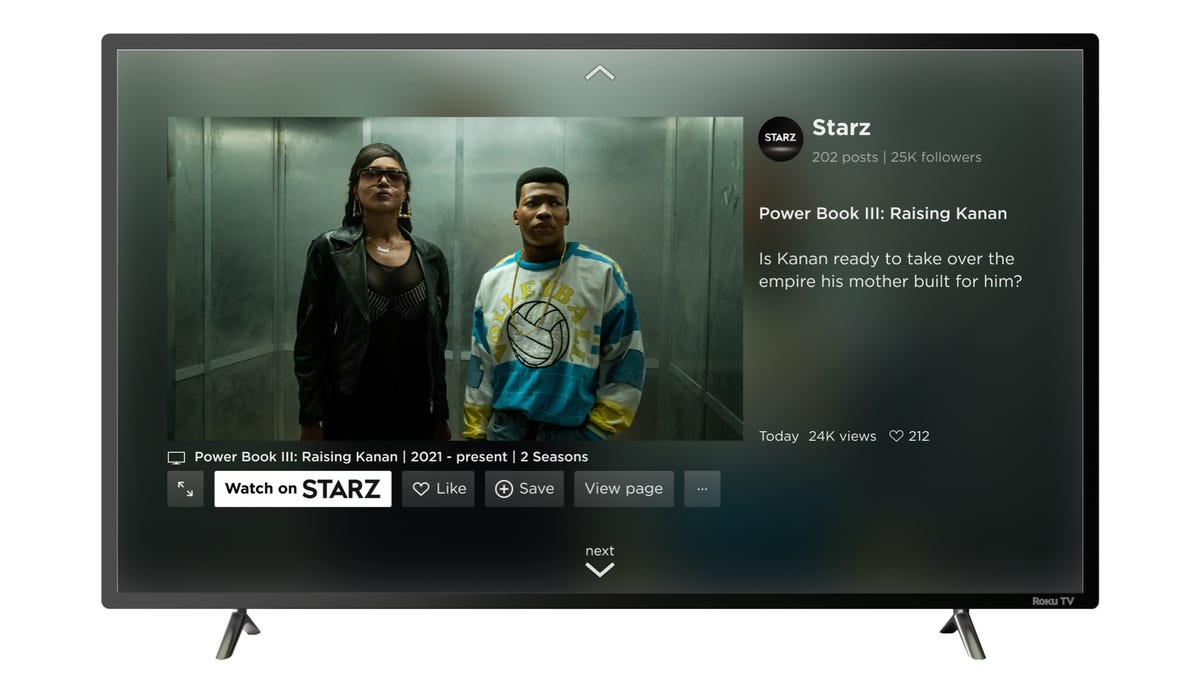

The Buzz is a new section of the menu designed to highlight new TV shows and movies.
Roku
The voice feature on Roku devices will get a small upgrade too. When multiple apps qualify for a voice search result, a prompt appears showing them all and you can specify “the second one,” for example, to launch it. The Live channel guide is also adding categories including Recents, Favorites and Subscribed, as well as genres, but it doesn’t integrate with live TV streaming services like Sling TV or YouTube TV.
Bluetooth, but only for Roku Ultra and soundbars
One of Roku’s most popular features is private listening, which allows you to stream the audio from your TV directly to the Roku app on your mobile phone, skipping your TV’s speakers entirely. It also works with certain Roku remotes, for example the Voice Remote Pro, which allow you to connect wired headphones.
The new software update lets you pair your own Bluetooth devices, including Bluetooth wireless headphones, directly to compatible Roku devices. The catch? It only works with Roku Ultra and Roku soundbars, namely the Streambar and Streambar Pro. It won’t work with other Roku devices, such as the cheaper Streaming Stick 4K, or with Roku TVs.
Roku Ultra
$100 at Target
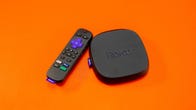
It’s worth noting that Roku’s competitors have offered this feature for years. That includes most Fire TV devices, from the budget Fire TV Stick Lite on up, the Chromecast with Google TV, as well as numerous smart TVs running those systems and others (including Vizio, LG and Samsung).
In addition to the software update, Roku separately announced two new hardware devices. There’s a (mildly) refreshed version of the $30 Roku Express and a $130 subwoofer called the Roku Wireless Bass that works with the company’s soundbars and speakers.
The post Roku Update Adds Continue Watching, Save List, Bluetooth Private Listening first appeared on Joggingvideo.com.
]]>The post Vizio M first appeared on Joggingvideo.com.
]]>I’ve long considered Vizio’s M-Series one of the best TV values thanks to its excellent picture for the money, and the new 2022 M-Series Quantum X is even better. This mid-priced set has the best image quality of any M-Series yet. It’s bright with great contrast, a particular boon with high dynamic range video, and it also supports the best video signals PlayStation 5 and Xbox Series X can dish out.

8.0
Vizio M-Series Quantum X (2022)
$850 at Best Buy
Get Price Alerts
You’re receiving price alerts for Vizio M-Series Quantum X (2022)
Like
- Affordable
- Excellent picture quality
- Game-friendly extras like variable refresh rate and 4K/120Hz input
Don’t Like
- Weak smart TV system
- Slightly more-expensive TVs perform better
In my side-by-side comparison, the MQX didn’t look as good overall as my favorite TV for the money (the TCL 6-Series), but it is cheaper and comes close enough that you might be sorely tempted to save cash and go with the Vizio instead. Then there’s Vizio’s less-than-impressive smart TV system, which is more cluttered despite fewer apps than Roku and not nearly as capable as Google TV. However, that problem is easily solved by adding a good streaming device to the Vizio.
If you prioritize image quality and gaming capability but want to keep your budget in check, the Vizio MQX could be exactly what you’re looking for.


Now playing:
Watch this:
Vizio Parks a Literal Busload of New TV Tech on Our Doorstep
5:50
Vizio MQX sizes
I performed a hands-on evaluation of the 65-inch MQX, but this review also applies to other screen sizes in the series.
- Vizio M50QXM-K01, 50-inch
- Vizio M65QXM-K03, 65-inch
- Vizio M75QXM-K03, 75-inch
Unlike nearly every other TV series the MQX lacks a 55-inch size, instead going with the slightly smaller 50-inch screen that also has slightly different features and specifications. The 50-inch model has the ability to handle 1080p input at 240 frames per second, which Vizio says is an industry first (the 65- and 75-inch sizes don’t have this feature). This extra isn’t important for most people, because such signals are only found on high-end computer gaming video cards, but owners of those cards may appreciate it. The 50-inch model is also dimmer than the larger sizes, and all sizes also have different numbers of local dimming zones, but otherwise have similar specs and should provide similar picture quality.
Vizio is also selling a less-expensive version of the M-Series, the MQ6, available in sizes from 43 to 75 inches that I haven’t reviewed yet. Unlike the MQX reviewed here, it has a 60Hz refresh rate with lower brightness and no local dimming, so it likely delivers worse image quality. Both the MQ6 and MQX do have quantum dots for improved color.
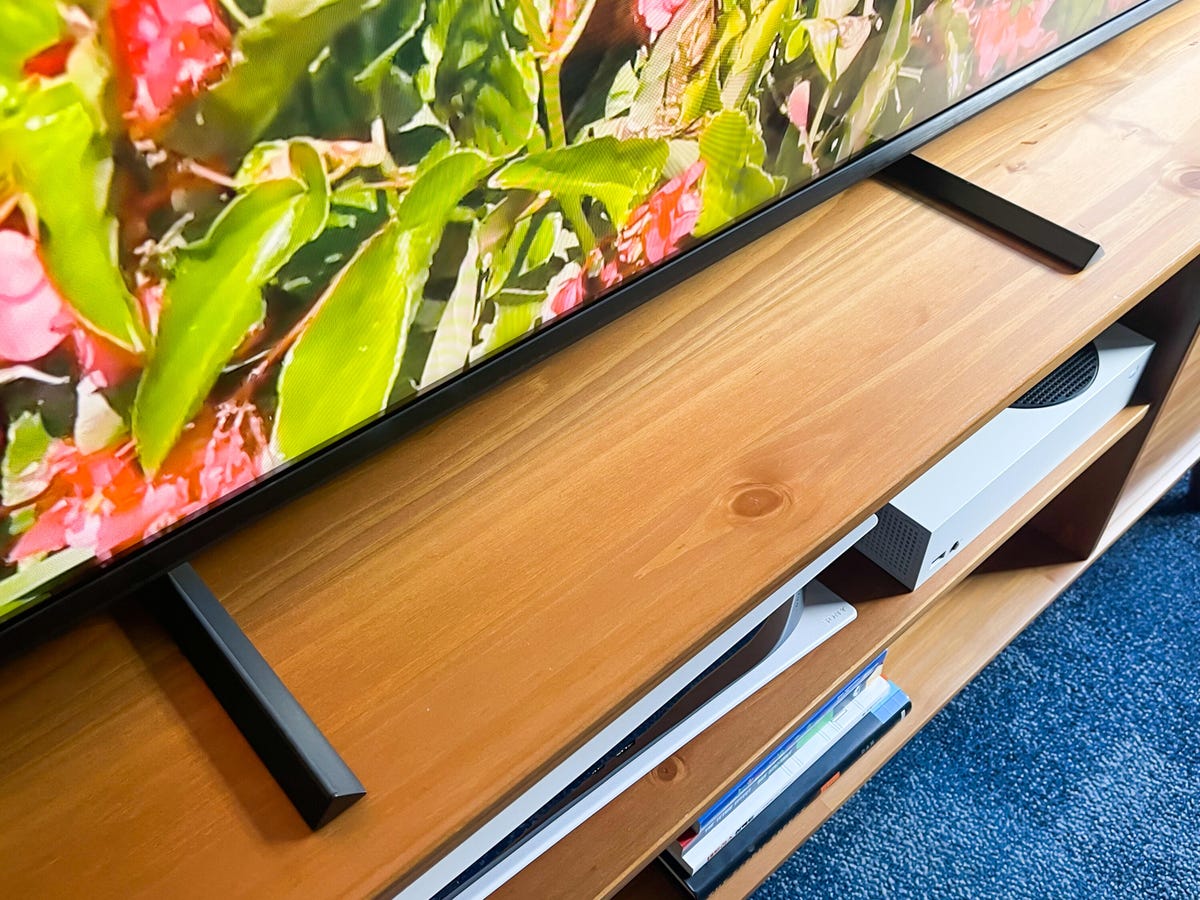
David Katzmaier/CNET
Design: Not bad, Vizio
Vizio has subtly improved the look of its TVs, and the MQX is nicer than you might be used to from this brand. A gray metallic bottom edge matches the frame and triangular stand supports, and the screen material runs almost to the edge. The stand legs are central rather than splayed out to the side (to more easily fit on a TV stand). I also appreciate having the option of two leg heights, one about 2 inches higher than the other, to accommodate soundbars.
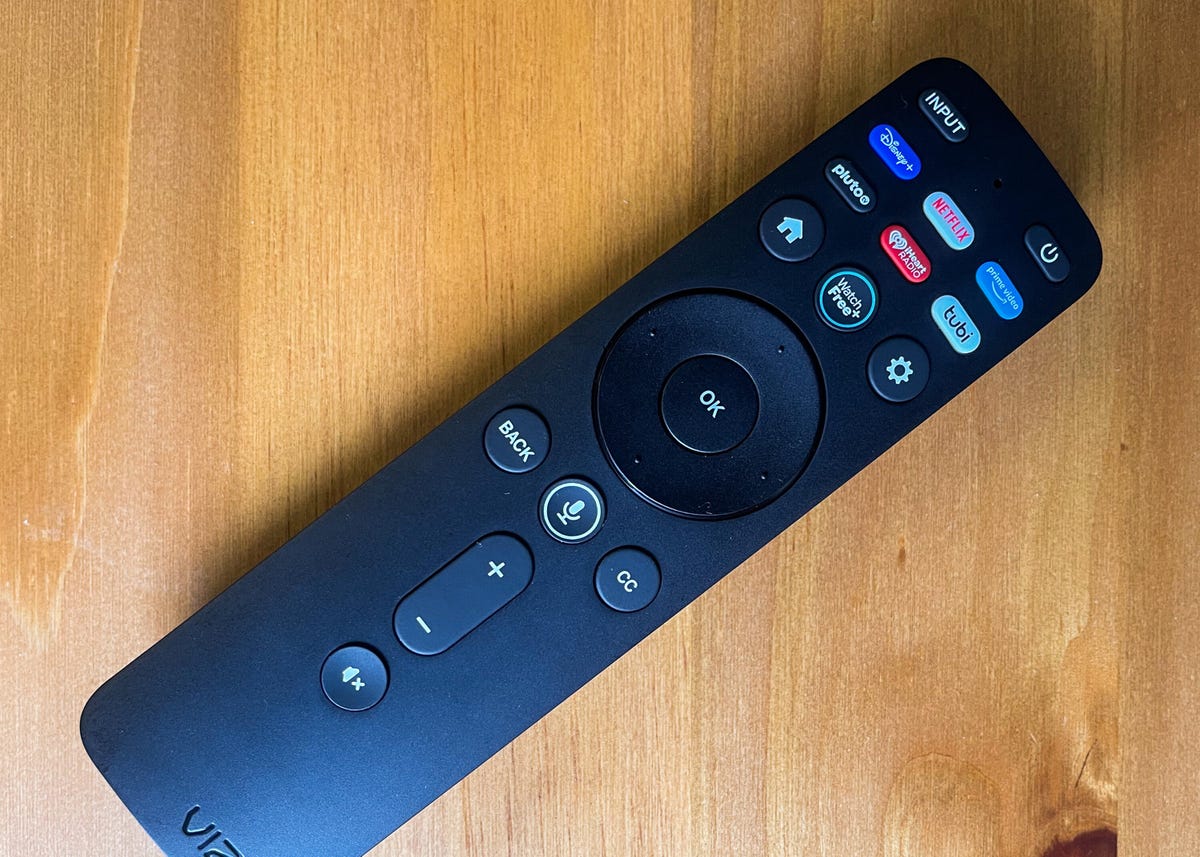

David Katzmaier/CNET
The remote has a simple layout and prominent buttons for various streaming services that skew “free” with Tubi and PlutoTV in addition to Vizio’s own WatchFree service. There’s also a key to access Vizio’s in-house voice system. It worked well enough in my tests, although don’t expect the same kind of capabilities you’ll get from Google Assistant, Amazon Alexa or Roku’s voice system.
When I said “show me comedies” for example, Vizio put up a bunch of thumbnails of movies and TV shows with little context. I preferred Roku’s results to that query, which were arranged in rows like “Available in 4K,” “New releases,” “Free,” “Available with your Netflix subscription” and offered more choices.
Vizio’s SmartCast smart TV menus haven’t changed much aside from adding a new “Inputs” button, a welcome addition… albeit one Roku TVs have offered for years. Although all the major streaming services are accounted for, the interface is worse than Roku and Google TV, and it’s about the same level of mediocre as LG and Samsung’s 2022 menus. The main issue with Vizio is cluttering the screen with a bunch of TV shows and movies I don’t care about. Roku’s grid of apps is simple and familiar, and if you want your homepage to show more relevant programming, Google TV does a much better job.


David Katzmaier
SmartCast plays well with phones — you can easily cast video and photos from Android or Apple iPhone using Chromecast and AirPlay, respectively — as well as with smart speakers like Echo and Nest, which you can use to command the TV hands-free.
Features: FALD and 120Hz and DV HDR, oh my!
Key features
| Display technology | LED LCD |
|---|---|
| LED backlight | Full array with local dimming |
| Resolution | 4K |
| HDR compatible | HDR10 and Dolby Vision |
| Smart TV | SmartCast |
| Remote | Standard with voice |
The MQX is the least-expensive 2022 Vizio TV and one of the cheapest TVs, period, to offer my favorite picture-enhancing extra for LCD-based TVs: full-array local dimming (FALD). That feature improves contrast and black levels and delivers better HDR by dividing the screen into separate dimming zones. The number of zones controls how precise the dimming can be, and while more zones doesn’t necessarily mean better picture quality, it usually helps. The MQX has fewer zones than more expensive TVs like the TCL 6-Series and Hisense U7H, with 16 zones on the 50-inch, 30 on the 65-inch and 42 on the 75-inch.
Unlike the M7 last year or the cheaper M6 series this year, the MQX has a true 120Hz refresh rate, which allows compatibility with 4K/120Hz signals from game consoles like Xbox Series X and Playstation 5 and worked well in my tests. Vizio supports both major HDR formats, HDR10 and Dolby Vision (DV), in the M-Series. So does every other major TV maker except Samsung (which lacks Dolby Vision).
The selection of inputs on the MQX is also solid but only one, HDMI 3, can handle the higher-bandwidth HDMI 2.1 signals, namely 4K/120Hz. That’s not a big deal unless you own both consoles and maybe a high-end PC gaming card. I was also surprised to see actual red and white RCA-style audio outputs; most TVs have a minijack for analog audio.
- Four HDMI inputs, one with HDMI 2.1
- USB 2.0 port
- Optical digital audio output
- Analog audio output (stereo RCA)
- RF (antenna) input
- Ethernet (LAN) port
Many TVs also have a headphone output, which the Vizio lacks, but you can pair a set of Bluetooth headphones — or another Bluetooth device, like a speaker — with the MQX.


David Katzmaier/CNET
Picture quality comparisons
For my comparisons I set the Vizio MQX up next to three other 65-inch TVs with local dimming. In ascending order of price: the TCL 6-Series, the Hisense U8H and the Samsung QN90B. All three have mini-LED backlights and are more expensive than the Vizio, but the MQX nicely held its own.
TV and movies: The MQX produced an excellent picture overall, with bright highlights, dark black levels, punchy contrast and accurate color. Watching the nature scenes from Spears and Munsil HDR Benchmark, the mountains, clouds and Yellowstone geysers appeared a bit dimmer on the Vizio. They were still nice and bright, and the same went for objects against black backgrounds, like the pen nib and honey dripper. Those backgrounds also looked lighter than on the Hisense and Samsung, if similar to the TCL, although the difference was very slight. Blooming or stray illumination around objects was minimal on the Vizio, especially considering its relatively few dimming zones.
Watching theatrical content, in this case the new 4K HDR version of Game of Thrones on HBO Max, the TVs separated a bit more. The TCL and especially the Samsung pulled ahead, with superior contrast and pop in mixed scenes like a firelit encounter between Daenerys and Jon, or the council in the map room at Dragonstone. Both the Hisense and the Vizio looked good but lacked that extra HDR oomph in highlights.
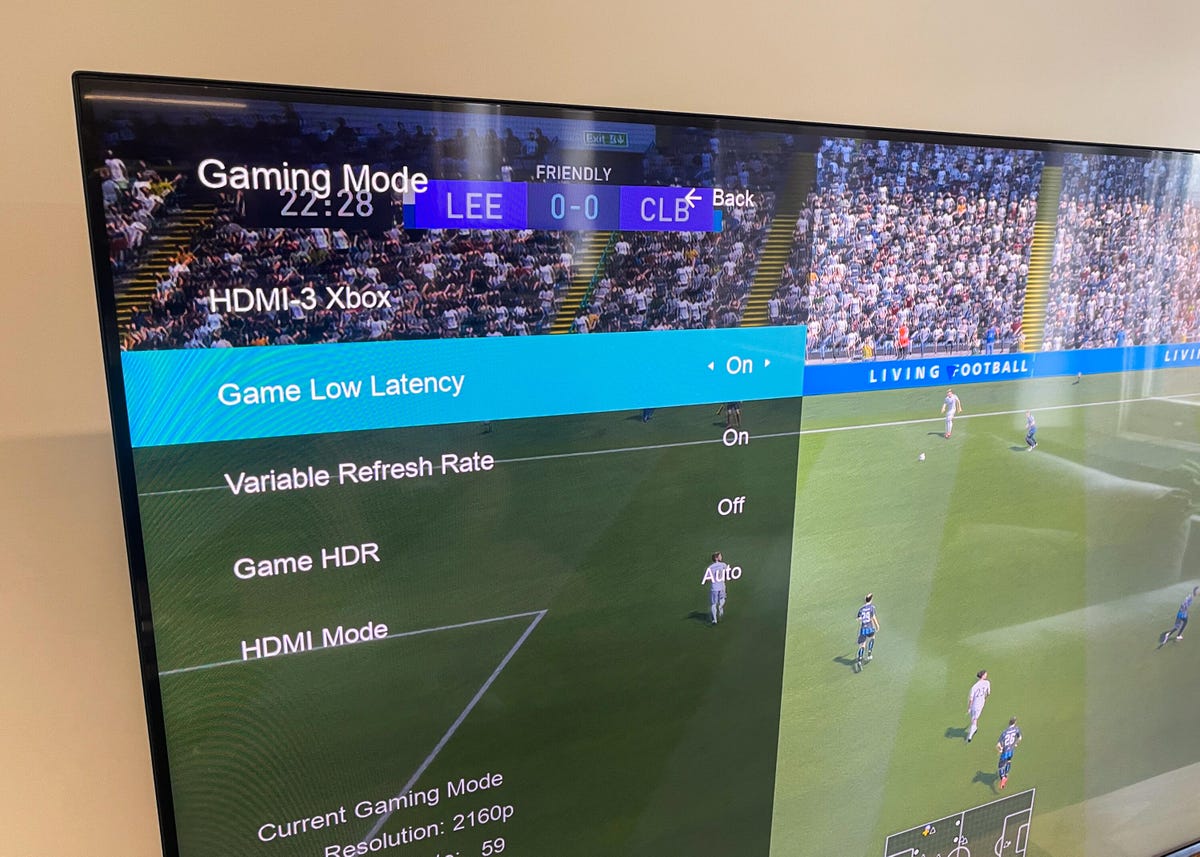

David Katzmaier/CNET
Gaming: While it doesn’t have the array of options found on new LG and Samsung TVs like specific picture modes for gaming, or fancy overlays confirming resolution and frame rate status, the MQX is a capable gaming TV. My Xbox Series X connected to the HDMI 3 input confirmed that 4K/120Hz was supported. Playing Assassin’s Creed Valhalla, the TV confirmed via pop-up that both HDR and AMD FreeSync VRR were active, and the action looked buttery smooth. I also discovered that Vizio’s System Information screen (Menu > Admin & Privacy > System Information) lists real-time frame rate and other gaming info, if you’re curious.
Video quality in Game mode was solid, but I’d recommend switching to the Warm color temperature (Settings > Picture > Color Temperature). After I did so colors looked more natural then on the Samsung or Hisense, and the image overall was more vibrant than the TCL’s Game mode, which looked slightly flat. I preferred the extra pop and brightness of the Samsung and Hisense overall for games, but the Vizio was nonetheless good. Input lag measured a respectable 15ms in both 1080p and 4K HDR.
Bright lighting: The 65-inch MQX is very bright for the money. It measured significantly brighter than the more-expensive Samsung Q60B, for example, albeit dimmer than the mini-LED-equipped sets in my comparison. Measured against other Vizios the MQX was brighter than last year’s M7 series and similar to the P-series in the most accurate modes.
Light output in nits
| TV | Brightest mode (SDR) | Accurate mode (SDR) | Brightest mode (HDR) | Accurate mode (HDR) |
|---|---|---|---|---|
| Samsung QN65Q90B | 2,625 | 974 | 3,316 | 1,981 |
| TCL 65R635 | 1,114 | 792 | 1,292 | 1,102 |
| Vizio P65Q9-J01 (2021) | 1,099 | 463 | 1,130 | 762 |
| Vizio M65QXM-K03 | 958 | 608 | 939 | 742 |
| Vizio M65Q7-J01 (2021) | 791 | 562 | 764 | 631 |
| Samsung QN55Q60B | 549 | 343 | 540 | 514 |
| LG OLED65C2 | 413 | 389 | 812 | 759 |
Note that Vizio says the 50-inch model is dimmer than the 65- and 75-inch sizes, but it didn’t specify a peak brightness number, only a “sustained” number of 400 nits. Based on Vizio’s specifications for the larger models, which are half those of the 50-incher, the 50-inch model’s peak brightness should be about 500 nits.
Vizio’s Calibrated picture mode delivered the most-accurate bright-room picture, which is well worth the loss of nits compared to the exceedingly inaccurate Vivid mode (the brightest) in my opinion. Vizio’s semi-matte was the worst in my lineup at reducing reflections and preserving black-level fidelity.
Uniformity and viewing angle: My review unit’s screen showed no major uniformity issues or bright/dark spots, and while the edges appeared slightly darker than the middle in test patterns, that difference was invisible with normal video. From off-angle the Hisense did a better job maintaining brightness and color, while the TCL and Vizio were each similarly mediocre.
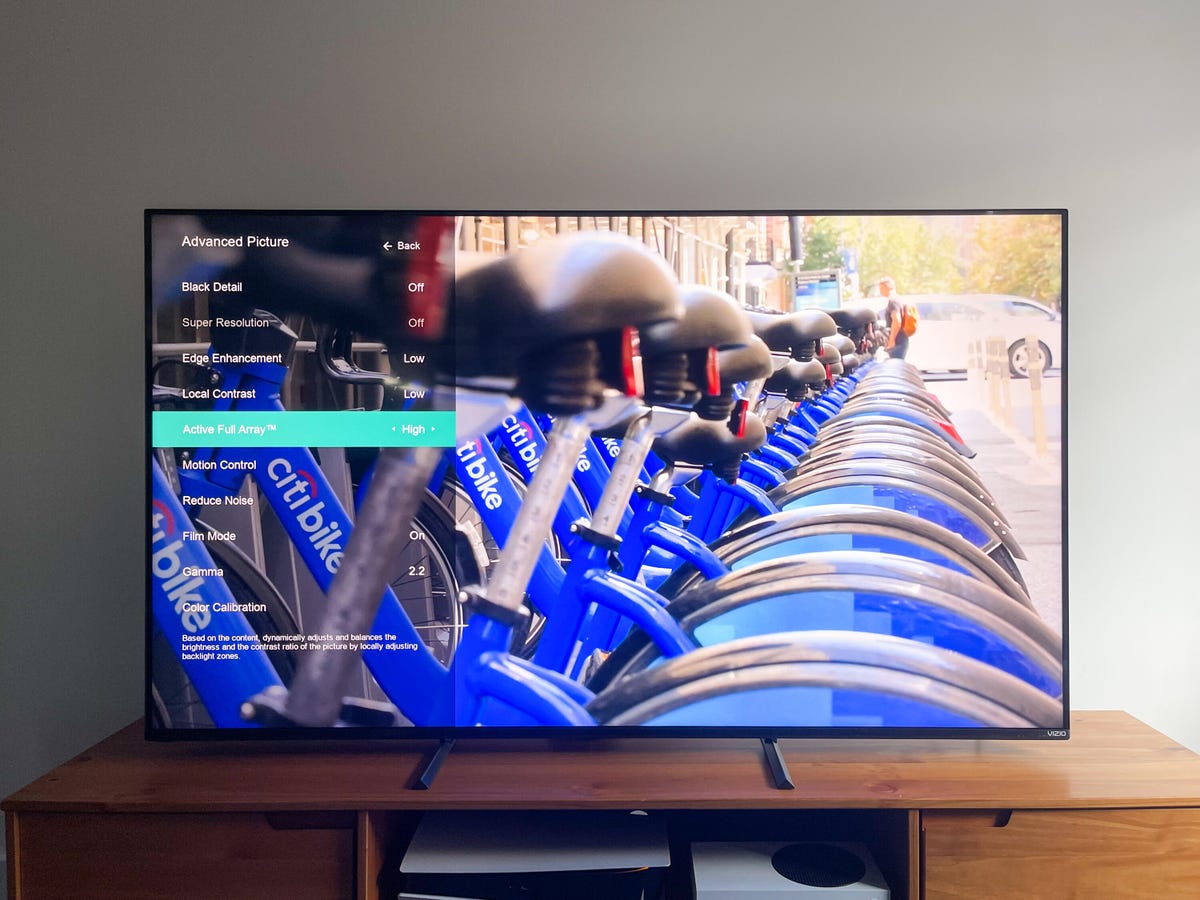

David Katzmaier
Picture setting and measurement notes
Calibrated Dark was the best picture mode overall for both HDR and standard dynamic range (SDR) material. In HDR, the MQX’s EOTF was more accurate than Calibrated, and it measured as bright. Color temperature in the best modes, Calibrated and Calibrated Dark, was less accurate than on most TVs in this class, with an overly-blue cast. Game mode in particular was quite inaccurate, but switching its color temperature to Warm as described above helped quite a bit. Adjusting the Judder reduction (Settings > Picture > Advanced Picture > Motion Control) introduces progressively higher smoothing, aka Soap Opera Effect, so I recommend leaving it turned off. Happily, it’s disabled in the two Calibrated modes.
Geek Box
| Test | Result | Score |
|---|---|---|
| Black luminance (0%) | 0.025 | Good |
| Peak white luminance (SDR) | 958 | Good |
| Avg. gamma (10-100%) | 2.14 | Good |
| Avg. grayscale error (10-100%) | 5.03 | Poor |
| Dark gray error (30%) | 5.06 | Poor |
| Bright gray error (80%) | 5.48 | Poor |
| Avg. color checker error | 3.59 | Average |
| Avg. saturation sweeps error | 3.26 | Average |
| Avg. color error | 3.00 | Good |
| 1080p/24 Cadence (IAL) | Pass | Good |
| Input lag (Game mode) | 15.33 | Good |
| HDR10 | ||
| Black luminance (0%) | 0.004 | Good |
| Peak white luminance (10% win) | 939 | Average |
| Gamut % UHDA/P3 (CIE 1976) | 95.66 | Good |
| ColorMatch HDR error | 3.06 | Average |
| Avg. color checker error | 2.94 | Good |
| Input lag (Game mode, 4K HDR) | 15.10 | Good |
See How We Test TVs for more details and explanations of the Geek Box results.
Portrait Displays Calman calibration software was used in this review.
The post Vizio M first appeared on Joggingvideo.com.
]]>The post Best Smart TV for 2022: Top Picks in Every Budget From Samsung, Roku, TCL, LG and More first appeared on Joggingvideo.com.
]]>Smart TVs have improved a lot since they first hit shelves, with partners like Roku, Amazon and Google snapping up all the major brands. You can transform just about any TV with an HDMI port into a “smart TV” by adding a streaming device, but it’s tough to beat the convenience of flipping your TV on and having all your favorite shows, movies and apps on the home screen. Most smart TVs come with popular streaming services like Netflix, Disney Plus and HBO Max already downloaded, so you can start watching as soon as it’s powered on.
Our TV reviews consider smart TV systems, sure, but we think that picture quality for the money is more important when purchasing a new TV. That’s because you can always “replace” the TV’s built-in system with a good streaming device, most of which cost less than $50. That’s why we don’t consider a particular smart TV OS one of the top factors to consider when buying a new TV: Picture quality, size, price and connection features are all more important.
Our list below is arranged in order of which TVs provide the best picture for the money, but we also note how much we like (or dislike) the built-in smart TV system. Here are our latest recommendations, and for TVs from last year (many of which are our top picks) we’ve included a “2022 outlook” section with information on the new model.


David Katzmaier/CNET
TCL 6-Series Roku TV
Best smart TV for the money
Nov 2020
Roku is one of our favorite streaming platforms because it has the most streaming app options, the simplest streaming platform interface and the best search. It also features a content-agnostic platform that doesn’t push any one media streaming service provider, like Amazon Prime Video or Apple, over another.
The TCL 6-Series Dolby Vision HDR TV pairs this operating system with an outstanding TV for a winning combination. It has an excellent image thanks to mini-LED tech and well-implemented full-array local dimming that helps it run circles around just about any other TV at this price. It’s also a solid choice for gamers, with a THX mode that combines low input lag and high contrast. No TV we’ve ever tested offers this much picture quality for as little cash.
This TV first came out in 2020 but is still a current model and remains our top choice. TCL also sells an 8K version of the 6-Series, but we don’t think it’s worth the extra money, as well as a Google-powered version that we have yet to review (although according to TCL its image quality is the same as this Roku version).
Sizes: 55-, 65-, 75-, 85-inch. (The price shown below is for the 65-inch size.)
2022 outlook: TCL has yet to announce a successor for this TV.
Read our TCL 6-Series (2020 Roku TV) review.
$1,000 at Amazon$1,000 at Best BuyGet Price AlertsYou’re receiving price alerts for TCL 6-Series Roku TV


David Katzmaier/CNET
LG OLED C1
Best high-end smart TV for the money
Nov 2021
With picture quality as good as any TV we’ve ever tested and a price that’s not too crazy, the LG C1 OLED TV is still our go-to pick for people who prioritize picture and are willing to pay for it. It beats any non-OLED TV on this list, including the Samsung QN90A below, with its perfect black levels, unbeatable contrast and superb off-angle viewing. It also has the best gaming features, making it the perfect companion to an Xbox Series X or S, PlayStation 5 or both. The C1 comes in a wide variety of sizes as well, although the bigger models are really expensive.
One downside to the C1 is its WebOS smart TV platform. It was revamped in 2021 and it now features a full-screen homepage, similar to what you get with a Roku, Fire TV or Google TV. But it has fewer apps and more, well, junk. The top two-thirds of the screen are devoted to the weather, setup tips, a search window and a Trending Now section with a random collection of TV shows and movies. Below that is an app row and, farther down, sections devoted to inputs and particular streaming apps. In general it feels like a hodgepodge with too much going on — most systems are simpler and easier to grasp. This might be an instance where fans of a particular smart TV platform might want to purchase a streaming device separately.
We also reviewed the successor to the C1, the LG C2, and the two have essentially identical picture quality. The newer version brings a couple of minor improvements, including lighter weight and a 42-inch size. Since the 2021 C1 currently remains on sale for hundreds less than the 2022 C2, we recommend getting the C1 instead.
Sizes: 48-, 55-, 65-, 77-, 83-inch. (The price shown below is for the 65-inch size.)
Read our LG C1 series OLED TV review.
$2,200 at Target$2,097 at AmazonGet Price Alerts$2,200 at Best BuyYou’re receiving price alerts for LG OLED C1


David Katzmaier/CNET
LG OLED C2
Best high-end 2022 smart TV (so far)
The C2 is the first 2022 TV we’ve reviewed and it’s superb, but right now the 2021 model is a better deal. We side-by-side compared the C2 directly to last year’s C1. In terms of picture quality, the two were basically identical, despite the fact that LG touts the new “Evo” panel on the C2. Real improvements include carbon-fiber construction for up to 47% lighter weight — the 65-inch version we reviewed weighs 37 pounds with its stand, compared to 72 pounds for the 65-inch C1 — as well as some additional tweaks to game mode and a new “always on” feature. Those enhancements aren’t worth the price difference, so our advice is to buy a C1 now or wait until later this year, when the C1 sells out and the C2 gets a price cut.
Like the C1, the C2 is also bogged down by the WebOS smart TV system. Signing in to an LG account unlocks a new 2022 feature, customized recommendations and additional user accounts. LG touts the fact that you can set up favorite sports teams, for example, but most people will just go straight to the app and skip the clutter. On a TV this expensive you should just attach a good streaming device instead.
The C2 is also available in a 42-inch size, while the smallest C1 is a 48-inch model.
Sizes: 42-, 48-, 55-, 65-, 77-, 83-inch. (The prices shown below are for the 65-inch size.)
Read our LG C2 series OLED TV review.
$2,300 at Target$1,897 at AmazonGet Price Alerts$1,900 at Best BuyYou’re receiving price alerts for LG OLED C2
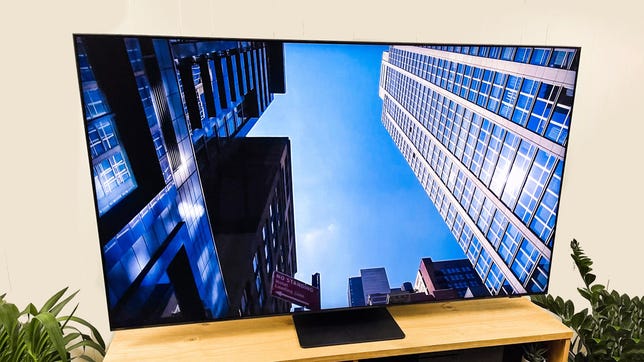

David Katzmaier/CNET
Samsung QN90A
Best OLED smart TV alternative
Looking for a high-end TV with spectacular image quality, but don’t want an OLED? The Samsung QN90A is your best bet. This TV uses QLED TV tech augmented by mini-LED for a brighter image than any OLED TV. The spectacular contrast of OLED still won out in our side-by-side tests, but the QN90A QLED screen comes closer than ever.
Samsung’s onscreen smart TV system is excellent, with quick responses and plenty of apps — we’d take it over LG or Vizio’s systems. We still like Roku and Android/Google TV (found on Sony TVs) better overall, however, because they have even more apps. Just like most TVs now (including Roku), Samsung has the Apple TV app and works with Apple’s AirPlay system.
Sizes: 50-, 55-, 65-, 75-, 85-inch. (The prices shown below are for the 65-inch size.)
2022 outlook: The 2022 version of the Samsung QN90A is called the QN90B. We haven’t reviewed it yet, but we expect it to have very similar image quality despite the fact that the 2022 version has a lower “Quantum HDR” spec (24x) then the 2021 version (32x). Samsung touts improved processing and a few extra features but nothing earth-shattering, and the 2022 QN90B currently costs hundreds of dollars more than the 2021 QN90A.
Read our Samsung QN90A series (2021) review.
$1,600 at Best Buy$1,744 at eBayGet Price AlertsYou’re receiving price alerts for Samsung QN90A
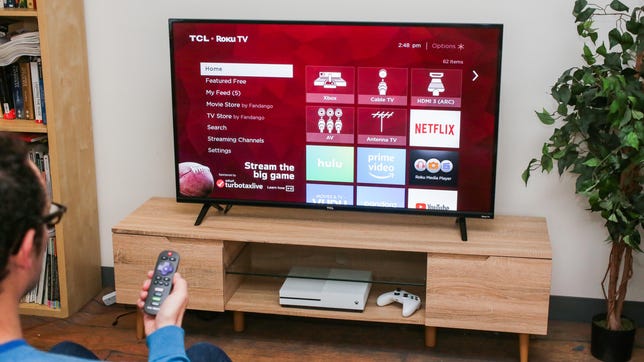

Sarah Tew/CNET
TCL 4-Series
Best cheap smart TV
Roku is our favorite platform for live TV streaming services like Netflix, Hulu and Amazon Prime Video, and it’s even better baked into the TV. This TCL 4-Series can’t beat any of the models above on image quality — its 4K resolution and HDR performance don’t do much to help the picture — but it’s perfectly fine for most people, especially at this price.
Note that TCL also makes a Google TV and an Android TV version of the 4-Series. We haven’t reviewed them, but we expect similar picture quality to the Roku version.
Sizes: 43-, 50-, 55-, 65-, 75-, 85-inch. (The prices shown below are for the 43-inch size.)
2022 outlook: TCL has yet to announce a successor for this TV.
Read our TCL 4-series Roku TV (2021) review.
$228 at WalmartGet Price AlertsYou’re receiving price alerts for TCL 4-Series
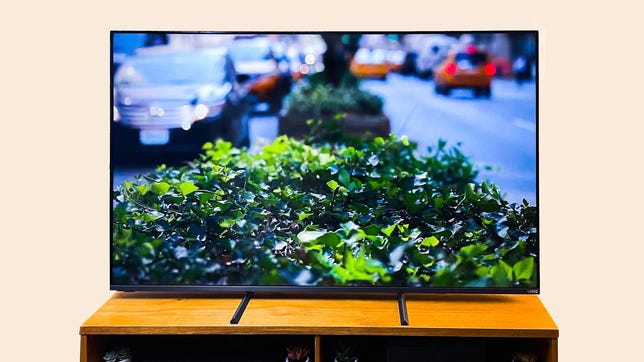

David Katzmaier/CNET
Vizio MQ7
Best alternative smart TV for tighter budgets
The Vizio MQ7 is one of the least expensive TVs to feature full-array local dimming, which lets it reproduce TV shows, movies and games with enough contrast and pop to do HDR justice. It’s a 60Hz model, not 120Hz, but it still handles variable refresh rate games for extra smoothness. If you can’t save up for the TCL 6-series, the Vizio MQ7 makes an excellent consolation prize.
The company has made more changes to its SmartCast system but it falls short of Roku, Android TV, LG or even Samsung’s proprietary systems. The main homepage is packed with TV show, movie and channel suggestions you probably don’t care about, and the stuff you’ll probably use most (the streaming apps themselves) is limited to a single row.
Sizes: 50-, 55-, 58- 65-, 70-, 75-inch. (The prices shown below are for the 55-inch size.)
2022 outlook: Vizio has yet to announce a successor for this TV.
Read our Vizio M-7 Series Quantum (2021) review.
$550 at Best BuyGet Price AlertsYou’re receiving price alerts for Vizio MQ7


Geoffrey Morrison/CNET
Vizio V-Series
Best cheap smart TV runner-up
Vizio’s V-series is our favorite budget alternative to the TCL 4-Series Roku TV. We liked Roku’s smart TV system better (sound familiar?), but the V-series has some advantages, including a better remote with voice and more advanced picture settings. Picture quality between the two was basically the same, so if you don’t have a preference, it makes sense to get the cheapest one.
Sizes: 43-, 50-, 55-, 58- 65-, 75-inch. (The prices shown below are for the 55-inch size.)
2022 outlook: Vizio has yet to announce a successor for this TV.
Read the Vizio V-Series (2021) review.
$370 at Target$473 at AmazonGet Price Alerts$371 at Best BuyYou’re receiving price alerts for Vizio V-Series


David Katzmaier/CNET
Sony X90J
Best midpriced smart TV alternative to TCL, Vizio
With excellent picture quality, anchored by full-array local dimming and plenty of brightness to make HDR content shine, the X90J is Sony’s answer to the TCL 6-Series and step-up Vizio models. This TV’s sleek looks and built-in NextGen TV tuner score points, as does its next-gen console support — including variable refresh rate (VRR), enabled by a software update in March 2022. If you want an “S” brand, this is one of the best values we’ve tested.
The Google TV smart TV system is our second-favorite after Roku, and good enough that you probably don’t need to get an additional streaming device. It features excellent voice support with Google Assistant, a powerful onscreen menu and more apps than any system except Roku.
Sizes: 50-inch, 55-inch, 65-inch, 75-inch. (The prices shown below are for the 55-inch size.)
2022 outlook: The successor to the X90J is the X90K. We haven’t reviewed the new model yet but its image quality specifications are largely similar to the 2021 version, so we don’t expect many picture quality differences. Unlike the 2021 version, the new model ships with VRR enabled out of the box.
Read our Sony X90J series (2021) review.
$1,500 at Best Buy$1,180 at eBayGet Price AlertsYou’re receiving price alerts for Sony X90J
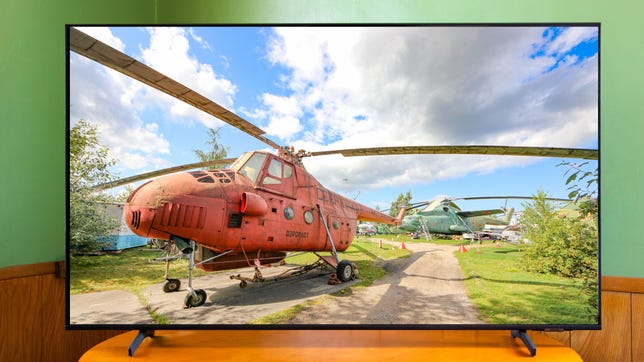

David Katzmaier/CNET
Samsung Q60A
Best design in a midprice smart TV
Samsung is the TV brand that sells more TVs than anyone and one of the most popular is the Q60A series. Its sleek OLED screen design stands out compared with the other TVs on this list — although the ultrathin OLED models are even sleeker — it offers better features and image quality than budget models like the TCL 4-Series, and it comes in a vast array of sizes. The TVs above are all superior values, but if you want a Samsung TV and can’t afford the QN90A, this is a great choice.
As far as apps go, you get all the standard options like Netflix, Vudu, HBO Max and so on. The Q60A’s interface isn’t nearly as in-your-face about streaming as, say, the Vizio (and the Roku-enabled TCL, to a lesser extent). The apps are grouped in a small row at the bottom of the screen, like the smart TVs of yore. There’s also Samsung TV Plus, which is essentially like free basic cable but you can’t fast-forward through ads.
Sizes: 43-, 50-, 55-, 60-, 65-, 70- 75-, 85-inch. (The prices shown below are for the 55-inch size.)
2022 outlook: The successor to the Samsung Q60A is the Q60B. We haven’t reviewed it yet but according to Samsung’s web site its specifications are basically the same as the 2021 version, so we expect similar picture quality. The Q60A is slightly cheaper than the Q60B, so it’s our pick.
Read our Samsung Q60A series (2021) review.
$700 at Best Buy$848 at WalmartGet Price AlertsYou’re receiving price alerts for Samsung Q60A
How does CNET test smart TVs?
Our TV reviews follow a rigorous, unbiased evaluation process honed over nearly two decades of TV reviews. Our primary TV test lab has specialized equipment for measuring light and color, including a Konica Minolta CS-2000 spectroradiometer, a Murideo Sig-G 4K HDR signal generator and an AVPro Connect 8×8 4K HDR distribution matrix. We use Portrait Displays CalMan Ultimate software to evaluate every TV we review. In every CNET TV review, three or more similar TVs are compared side by side in various lighting conditions playing different media, including movies, TV shows and games, across a variety of test categories, from color to video processing to gaming to HDR. Our reviews also account for design, features, HDMI input and gaming compatibility and other factors.
When specifically evaluating smart TV performance, we use all of the major features available on the platform and note how they stack up against the competition. Our metrics include: overall platform ease-of-use, effective layouts and design, search capabilities, privacy settings, the number of apps and their performance, and the overall speed and reliability of the system.
TV FAQs
We’ll post the answers to commonly asked TV questions below. If you have any others, feel free to reach out on Twitter (@dkatzmaier), or by clicking the little envelope icon on my CNET profile page.
What is the best smart TV system for streaming?
At CNET our favorite is Roku for its simplicity, while Google TV is our runner up for its impressive integration with other Google services such as Google Photos and YouTube TV. Samsung TV’s system is our third choice, with Amazon Fire TV and LG left as some of our least favorite options.
In any case we don’t consider the built-in smart TV system that important because you can always connect a streaming device to any TV.
What about Amazon Fire smart TVs?
Amazon makes a full range of smart TVs that run on their Fire operating system. The Fire TV platform is not one of our favorites because of the fact that ads are featured prominently throughout. We just don’t appreciate the TV becoming a giant rotating billboard for content or ads when in screensaver mode. In addition, we’ve found other TVs tend to have better picture quality than most Fire TVs.
The Toshiba M-Series Fire TVs seem like they could buck this trend. We’ve yet to review one, but will update this list when we do.
Do smart TVs come with Alexa and Google?
Many smart TVs come with some kind of voice assistant. All Amazon Fire TVs come with Alexa built in, while Sony, TCL and Hisense TVs that run on Google’s operating system offer Google Assistant. Many new Samsung and LG TVs come with both Google Assistant and Amazon Alexa built-in as well. Roku TVs and Vizio TVs, meanwhile, respond to voice commands but don’t work with Alexa or Google Assistant.
On most of these TVs you’ll need to speak into the remote to use voice commands, but some also respond to hands-free “Alexa” or “Hey Google” wake words, just like a smart speaker. And many TVs can also be paired with a smart speaker, such as an Echo Dot or Google Nest Mini, to receive voice commands.
How big a TV should I get?
In our opinion bigger is better, and your money is best spent on large screen sizes rather than a slight upgrade in image quality. The answer also depends on room size and seating distance: If you have a big room and sit farther away, you’ll want a bigger TV. The answer also depends on room size and seating distance.
How do I get the best TV sound?
Most TVs sound terrible because their thin cabinets don’t have room for decent-size speakers or bass. If you want to get good sound you should buy an external audio system. Even an inexpensive soundbar will deliver much better audio quality than a TV’s built-in speakers. The Roku Streambar is a good example of a device that integrates a streaming system with a soundbar into one product.
More Home Entertainment Recommendations
- Buying a New TV in 2022
- Best Soundbars for 2022
- Best Streaming Device in 2022
- Best TV Antennas for Cord Cutters, Starting at Just $10
- Dolby Atmos: Why It’s Cool, How It Works and How to Get It
- Best Sonos Speakers Starting at $100
- QLED vs. OLED: Which TV Tech Should You Buy?
- HDR Formats like Dolby Vision, HDR10, Technicolor and HLG Explained
- Best TVs for Gaming
- Best 75-Inch TVs for 2022
The post Best Smart TV for 2022: Top Picks in Every Budget From Samsung, Roku, TCL, LG and More first appeared on Joggingvideo.com.
]]>The post Best 75 first appeared on Joggingvideo.com.
]]>TV shoppers often wonder how big they should go. At CNET, our advice is to go as big as you can afford. If you have the space for it, a 75-inch TV is truly impressive. You are likely to be surprised that the cheapest ones cost less than $700. Several of the best 75-inch TVs for the money are featured on our list of the Best TVs for 2022, including some of those high-end OLED TVs. Technically they measure 77 inches, but they’re still included.
The list below represents the best TVs I’ve reviewed in CNET’s test lab, where I compare them side by side to see which is most worth buying. I’ve actually reviewed the 65-inch sizes in the series listed below, but the 75-inch and 77-inch versions are basically identical beyond screen size. I update this list periodically and if I haven’t reviewed the newest version yet, I’ll include an “Outlook” section to give you a sense of what you’re missing (or not).
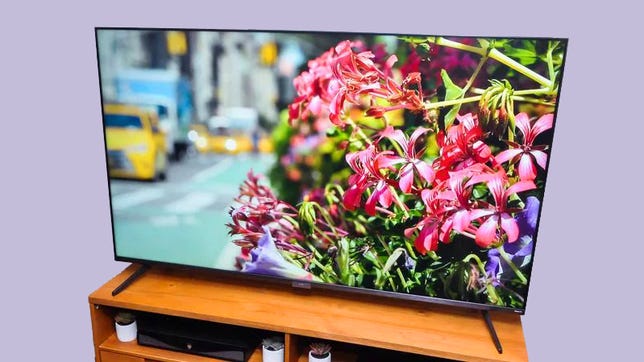

David Katzmaier/CNET
TCL 75R635
Best 75-inch TV for the money
Nov 2020
No TV I’ve ever tested offers this much picture quality for as little cash. The TCL 6-Series has an excellent image, thanks to mini-LED tech and well-implemented full-array local dimming that helps it run circles around just about any other TV at this price. It’s also a solid choice for gamers with a THX mode that combines low input lag and high contrast. As if that’s not enough, the Roku TV operating system is our hands-down favorite.
This TV came out in 2020 but is still a current model and remains my top choice so far. TCL also sells an 8K version of the 6-Series, but I don’t think it’s worth the extra money, as well as a Google-powered version I have yet to review (although according to TCL, its image quality is the same as this Roku version).
Like: Excellent overall image qualitySuperior brightness for the priceGreat game mode performanceRoku smart TV is simple, capableDon’t like:Some issues with low-light dimming
Key features:Display technology: LED LCD (Mini-LED)LED backlight: Full array with local dimmingNumber of zones: 240Resolution: 4KRefresh rate: 120HzHDR compatible: HDR10 and Dolby VisionSmart TV: Roku TVRemote: VoiceHDMI support: 1440p/120Hz, VRR, eARC, ALLM
Outlook: TCL has yet to announce a successor to this TV.
Read our TCL 6-Series (75R635) review.
$1,760 at Amazon$1,330 at Best BuyGet Price AlertsYou’re receiving price alerts for TCL 75R635


David Katzmaier/CNET
LG OLED77C1PUB
Best high-end 77-inch TV for the money
Nov 2021
With picture quality as good as any TV I’ve ever tested and a price that’s not too crazy, the LG C1 OLED TV is still my go-to pick for people who prioritize picture and are willing to pay for it. It beats any non-OLED TV on this list, including the Samsung QN90A below, with its perfect black levels, unbeatable contrast and superb off-angle viewing. It also has the best gaming features, making it the perfect companion to an Xbox Series X or S, PlayStation 5 or both.
I also reviewed the successor to the C1, the LG C2, and the two have essentially identical picture quality. The newer version brings a couple of minor improvements, including lighter weight and a couple new gaming modes. Since the 2021 C1 currently remains on sale for hundreds less than the 2022 C2, I recommend getting the C1 instead.
Like:Better picture quality than any non-OLED TVSuperior contrast and off-angle imageBest-in-class gaming featuresSleek styling with ultrathin panelDon’t like:Expensive
Key features:Display technology: OLEDLED backlight: N/AResolution: 4KRefresh rate: 120HzHDR compatibility: HDR10 and Dolby VisionSmart TV: Web OSRemote: MotionHDMI 2.1 support: 4K/120Hz, VRR, eARC, ALLM
Read our LG C1 series OLED TV review.
$2,700 at Best Buy$2,697 at CrutchfieldGet Price Alerts$2,697 at AmazonYou’re receiving price alerts for LG OLED77C1PUB
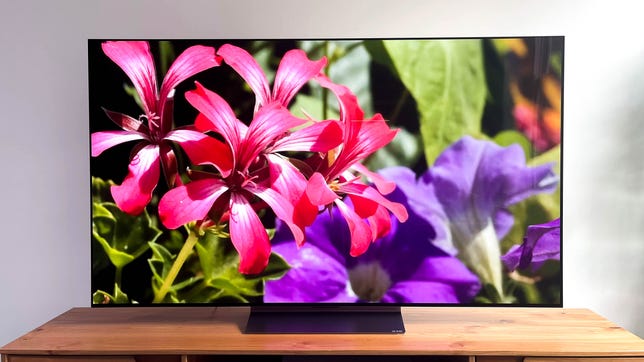

David Katzmaier/CNET
LG OLED77C2P
Best high-end 77-inch 2022 TV (so far)
The C2 is the first 2022 TV we reviewed and it’s superb, but right now the 2021 model is a better deal. We compared the C2 directly with last year’s C1, side by side. In terms of picture quality, the two were basically identical, despite the fact that LG touts the new “Evo” panel on the C2. Real improvements include carbon-fiber construction for lighter weight — the 77-inch version weighs just 54 pounds with its stand, versus 79 pounds for the 77-inch C1 — as well as some additional tweaks to game mode and a new “always on” feature. Those enhancements aren’t worth the price difference, so our advice is to buy a C1 now or wait until later this year, when the C1 sells out and the C2 gets a price cut.
Like:Better picture quality than any non-OLED TVSuperior contrast and off-angle imageBest-in-class gaming featuresSleek styling with ultralight, thin panelDon’t Like:ExpensiveNo major picture quality improvements over the C1 from 2021
Key features:Display technology: OLEDLED backlight: N/AResolution: 4KRefresh rate: 120HzHDR compatibility: HDR10 and Dolby VisionSmart TV: Web OSRemote: MotionHDMI 2.1 support: 4K/120Hz, VRR, eARC, ALLM
Read our LG OLED C2 Series 2022 review.
$3,000 at Target$2,997 at AmazonGet Price Alerts$3,000 at Best BuyYou’re receiving price alerts for LG OLED77C2P


Bobby Oliver/CNET
Samsung QN75QN90B
Best 75-inch OLED TV alternative
Looking for a high-end TV with spectacular image quality, but don’t want an OLED? The Samsung QN90B is your best bet. This TV uses QLED TV tech augmented by mini-LED for a brighter image than any OLED TV. The spectacular contrast of OLED still won out in our side-by-side tests, but the QN90B QLED screen comes closer than ever.
Like:Best non-OLED picture quality we’ve ever testedIncredible brightness with minimal bloomingStylish design, packed with featuresDon’t like:ExpensiveSlightly worse contrast, off-angle and uniformity than OLED
Key features:Display technology: LED LCD (Mini-LED)LED backlight: Full array with local dimmingNumber of zones: UndisclosedResolution: 4KRefresh rate: 120HzHDR compatible: HDR10 and HDR10+Smart TV: TizenRemote: VoiceHDMI 2.1 support: 4K/120Hz, VRR, eARC, ALLM
In summer 2022 the older version of this TV, the QN90A, remains on sale for hundreds less. It’s also an excellent performer but it’s slightly dimmer than the QN90B. It also lacks some of the 2022 model’s features, including the new game hub with cloud gaming.
Read our Samsung QN90B series review.
$2,800 at Samsung$2,798 at AmazonGet Price Alerts$2,800 at Best BuyYou’re receiving price alerts for Samsung QN75QN90B


Sarah Tew/CNET
TCL 75S435
Best budget 75-inch TV
Roku is our favorite platform for live TV streaming services like Netflix, Hulu and Amazon Prime Video, and it’s even better baked into the TV. This TCL 4-Series can’t beat any of the models above on image quality — its 4K resolution and HDR performance don’t do much to help the picture — but it’s perfectly fine for most people, especially at this price.
Note that TCL also makes a Google TV and an Android TV version of the 4-Series. We haven’t reviewed them, but we expect similar picture quality to the Roku version.
Like:Hard to beat the priceEasy-to-use Roku interfaceDon’t like:Cheap-feeling remoteOnly average performanceHDR doesn’t look much better than SDR
Key features:Display technology: LED LCDLED backlight: DirectNumber of zones: N/AResolution: 4KRefresh rate: 60HzHDR compatible: HDR10Smart TV: Roku TVRemote: StandardHDMI support: ARC
Outlook: We haven’t reviewed the latest version of this TV, the TCL 75S455, but it has similar specifications and we expect it to perform basically the same as this model.
Read our TCL 4-series Roku TV (2021) review.
$563 at Best BuyGet Price AlertsYou’re receiving price alerts for TCL 75S435


David Katzmaier/CNET
Sony XR75X90J
Best midpriced 75-inch alternative to TCL, Vizio
With excellent picture quality, anchored by full-array local dimming and plenty of brightness to make HDR content shine, the X90J is Sony’s answer to the TCL 6-Series and step-up Vizio models. This LED TV’s sleek looks and the Google TV operating system score additional points, as does its next-gen console support — including variable refresh rate (VRR), enabled by a software update in March 2022 — and built-in NextGen TV tuner. This Sony TV is perfect for PS5 gaming and works with Alexa & Google Assistant. If you want an “S” brand, this is one of the best values we’ve tested.
Like:Excellent image qualityCapable Google TV smart systemSolid connectivitySubtle, understated designDon’t like:More expensive than competing TVs with similar picture quality
Key features:Display technology: LED LCDLED backlight: Full array with local dimmingNumber of zones: UndisclosedResolution: 4KRefresh rate: 120HzHDR compatible: HDR10 and Dolby VisionSmart TV: Google TVRemote: VoiceHDMI 2.1 support: 4K/120Hz, VRR, eARC, ALLM
Outlook: The successor to the X90J is the X90K, currently priced around the same as this model. We haven’t reviewed the new model yet, but its image quality specifications are largely similar to the 2021 version, so we don’t expect many picture quality differences. Unlike the 2021 version, the new model ships with VRR enabled out of the box.
Read our Sony X90J series (2021) review.
$2,100 at Best BuyGet Price AlertsYou’re receiving price alerts for Sony XR75X90J


James Martin/CNET
Best 75-inch midrange TV design, features
Samsung QN75QN60B
Samsung is the brand that sells more TVs than anyone, and one of its most popular is the Q60 series. Its sleek QLED screen design stands out compared with the other TVs on this list — even though the ultrathin OLED models are sleeker — and it offers better features, image quality and more sizes than models like the TCL 4-Series and Sony X80K. The TVs listed in this article are all superior values, but if you want a Samsung TV and can’t afford the QN90A, this is a great choice.
Note that the 2021 version, the Q60A, is still on sale and can be cheaper than the Q60B. The newer version measured brighter in our tests, but if you want the best deal, stick with the Q60A if it’s still available.
Like: Sleek design and excellent remoteBright image with solid contrastInformative status screen for gamingDon’t like:More expensive than competing TVs with better picture qualityCluttered smart TV menus
Key features:Display technology: LED LCDLED backlight: DirectNumber of zones: N/AResolution: 4KRefresh rate: 60HzHDR compatible: HDR10 and HDR10+Smart TV: TizenRemote: VoiceHDMI support: eARC
$1,400 at Target$1,400 at Best BuyGet Price Alerts$1,298 at CrutchfieldYou’re receiving price alerts for Best 75-inch midrange TV design, features
How does CNET test TVs?
Our TV reviews follow a rigorous, unbiased evaluation process honed over nearly two decades of TV reviews. Our primary TV test lab has specialized equipment for measuring light and color, including a Konica Minolta CS-2000 spectroradiometer, a Murideo Sig-G 4K HDR signal generator and an AVPro Connect 8×8 4K HDR distribution matrix. We Portrait Displays CalMan Ultimate software to evaluate and calibrate every TV we review. In every CNET TV review, three or more similar TVs are compared side-by-side in various lighting conditions with different content, including movies, TV shows and games, across a variety of test categories, from color to video processing to gaming to HDR. Our reviews also account for design, features, smart TV performance, HDMI input and gaming compatibility and more.
Read more: How We Test TVs
75-inch TV FAQs
Is a 75-inch TV too big?
It depends on your room size, seating distance and personal taste. For a large living room or den, a 75-inch TV is generally excellent, but it’s too big for smaller living rooms or most bedrooms. If you sit closer to the screen you don’t need as large a TV for the best experience. For maximum theatrical impact, according to THX and SMPTE, you should be between 7.5 and 10 feet from a 75-inch screen, although many viewers will find it more comfortable to sit a bit further back than that. Every 75-inch TV has 4K resolution, and if you have 20/20 vision you can sit as close as about 4.5 feet from the screen and still not discern individual pixels.
How wide is a 75-inch TV?
Most 75-inch TVs measure between 65 and 67 inches wide. Because the frames around newer TV screens are typically quite narrow, 75-inch TV widths don’t vary much. Models with very slim frames are on the lower end — the 75-inch Samsung QN90A measures 65.7 inches wide for example, while the slightly thicker-framed 75-inch TCL 4-Series is 66.1 inches wide. If you’re not planning to wall-mount the TV, you generally want the piece of furniture supporting the TV to measure at least as wide as the TV itself, and preferably a few inches wider. Refer to the manufacturer’s website for exact dimensions of a particular 75-inch or 77-inch TV.
How much does a 75-inch TV weigh?
A 75-inch TV weighs between 75 and 100 pounds with its stand, but this varies significantly depending on the type of TV. The TCL 4-Series 75-inch TV weighs 75 pounds with stand, for example, while the 75-inch Samsung QN90A weighs 98.8 pounds with stand. Removing the stand — which often consists of a pair of little legs under the panel — allows you to wall-mount the TV and reduces its weight (stands can weigh up to 20 pounds). Shipping weight (box, accessories, etc.) adds another 10 to 20 pounds. Refer to the manufacturer’s website for exact weights of a particular 75-inch TV.
More home entertainment recommendations
- Buying a New TV in 2022
- Best Soundbars for 2022
- Best Streaming Device for 2022
- Best TV Antennas for Cord-Cutters
- Dolby Atmos: Why It’s Cool, How It Works and How to Get It
- Best Sonos Speakers
- QLED vs. OLED: Which TV Tech Should You Buy?
- HDR Formats like Dolby Vision, HDR10, Technicolor and HLG Explained
- Best TVs for Gaming
The post Best 75 first appeared on Joggingvideo.com.
]]>The post Best 65 first appeared on Joggingvideo.com.
]]>If you’ve got room for a big TV, you should make use of it. Here at CNET we recommend getting the biggest model you can, and for many people this turns out to be a 65-inch TV. These days, consumers and manufacturers are both defaulting to it in equal measure. A 65-inch TV has a spot in just about every brand’s TV lineup — and we review the lot by pitting the 65-inch size of each model side-by-side with its competitors. Finally, the best 65-inch TV for your needs and budget will often hit that size-to-cost sweet spot, as they usually sell for a great deal less than their 75-inch TV counterparts.
With that in mind, check out our list of the best 65-inch TVs. In the summer of 2022, our best TV advice is still to buy a 2021 model and some have yet to be replaced. We’ll update this list periodically and if we haven’t reviewed the newest version yet, we’ll include a “2022 Outlook” section to give you a sense of what you’re missing (or not).
Read more: There’s Actually a Better Place to Mount Your TV


Sarah Tew/CNET
TCL 65R635
Best 65-inch TV for the money
Nov 2020
No TV we’ve ever tested offers this much picture quality for this little cash. The TCL 4K UHD TV has an excellent image, thanks to mini-LED tech, Dolby Vision HDR and well-implemented full-array local dimming that helps it run circles around just about any other TV at this price. It’s also a solid choice for gamers with a THX mode that combines low input lag and high contrast. As if that’s not enough, the Roku TV operating system is our hands-down favorite.
This TV came out in 2020 but it will stay on sale throughout 2021 and 2022 and remains our top choice so far. TCL also sells an 8K version of the 6-Series, but we don’t think it’s worth the extra money, as well as a Google-powered version we have yet to review (although according to TCL, its image quality is the same as this Roku version).
Like: Excellent overall image qualitySuperior brightness for the priceGreat game mode performanceRoku smart TV is simple, capable
Don’t like:Some issues with low-light dimming
Key features:Display technology: LED LCD (Mini-LED)LED backlight: Full array with local dimmingNumber of zones: 160Resolution: 4KRefresh rate: 120HzHDR compatible: HDR10 and Dolby VisionSmart TV: Roku TVRemote: VoiceHDMI support: 1440p/120Hz, VRR, eARC, ALLM
2022 outlook: TCL has yet to announce a successor to this TV.
Read our TCL 6-Series (2020 Roku TV) review.
$1,000 at Amazon$1,000 at Best BuyGet Price AlertsYou’re receiving price alerts for TCL 65R635


David Katzmaier/CNET
LG OLED65C1P
Best high-end 65-inch TV
Nov 2021
With picture quality as good as any TV we’ve ever tested and a price that’s not too crazy, the LG C1 OLED TV is still our go-to pick for people who prioritize picture and are willing to pay for it. It beats any non-OLED TV on this list, including the Samsung QN90A below, with its perfect black levels, unbeatable contrast and superb off-angle viewing. It also has the best gaming features, making it the perfect companion to an Xbox Series X or S, PlayStation 5 or both.
We also reviewed the successor to the C1, the LG C2, and the two have essentially identical picture quality. The newer version brings a couple of minor improvements, including lighter weight and a couple new gaming modes. Since the 2021 C1 currently remains on sale for hundreds less than the 2022 C2, we recommend getting the C1 instead.
Like:Better picture quality than any non-OLED TVSuperior contrast and off-angle imageBest-in-class gaming featuresSleek styling with ultrathin panel
Don’t like:Expensive
Key features:Display technology: OLEDLED backlight: N/AResolution: 4KRefresh rate: 120HzHDR compatibility: HDR10 and Dolby VisionSmart TV: Web OSRemote: MotionHDMI 2.1 support: 4K/120Hz, VRR, eARC, ALLM
Read our LG C1 series OLED TV review.
$2,200 at Target$2,097 at AmazonGet Price Alerts$2,200 at Best BuyYou’re receiving price alerts for LG OLED65C1P


Sarah Tew/CNET
TCL 65S435
Best budget 65-inch TV
Roku is our favorite platform for live TV streaming services like Netflix, Hulu and Amazon Prime Video, and it’s even better baked into the TV. This TCL 4-Series can’t beat any of the models above on image quality — its 4K resolution and HDR performance don’t do much to help the picture — but it’s perfectly fine for most people, especially at this price.
Note that TCL also makes a Google TV and an Android TV version of the 4-Series. We haven’t reviewed them, but we expect similar picture quality to the Roku version.
Like:Hard to beat the priceEasy-to-use Roku interface
Don’t like:Cheap-feeling remoteOnly average performanceHDR doesn’t look much better than SDR
Key features:Display technology: LED LCDLED backlight: DirectNumber of zones: N/AResolution: 4KRefresh rate: 60HzHDR compatible: HDR10Smart TV: Roku TVRemote: StandardHDMI support: ARC
2022 outlook: TCL has yet to announce a successor for this TV.
Read our TCL 4-series Roku TV (2021) review.
$370 at Best Buy$440 at AmazonGet Price AlertsYou’re receiving price alerts for TCL 65S435


Geoffrey Morrison/CNET
Vizio V655-J
Best budget 65-inch TV runner-up
Vizio’s V-series is our favorite budget alternative to the TCL 4-Series Roku TV. We liked Roku’s smart TV system better (sound familiar?), but the V-series has some advantages, including a better remote with voice and more advanced picture settings. Picture quality between the two was basically the same, so if you don’t have a preference, it makes sense to get the cheapest one.
Like:Excellent features for a low priceVoice remote with BluetoothLots of picture adjustments
Don’t like:Only average performanceHDR doesn’t look much better than SDRWorse built-in streaming than Roku
Key features:Display technology: LED LCDLED backlight: DirectNumber of zones: N/AResolution: 4KRefresh rate: 60HzHDR compatible: HDR10 and Dolby VisionSmart TV: SmartcastRemote: VoiceHDMI support: eARC
2022 outlook: Vizio has yet to announce a successor for this TV.
$450 at Target$450 at Best BuyGet Price AlertsYou’re receiving price alerts for Vizio V655-J


David Katzmaier/CNET
LG OLED65C2P
Best high-end 65-inch 2022 TV (so far)
The C2 is the first 2022 TV we’ve reviewed and it’s superb, but right now the 2021 model is a better deal. We compared the C2 directly with last year’s C1, side by side. In terms of picture quality, the two were basically identical, despite the fact that LG touts the new “Evo” panel on the C2. Real improvements include carbon-fiber construction for lighter weight — the 65-inch version weighs just 37 pounds with its stand, versus 72 pounds for the 65-inch C1 — as well as some additional tweaks to game mode and a new “always on” feature. Those enhancements aren’t worth the price difference, so our advice is to buy a C1 now or wait until later this year, when the C1 sells out and the C2 gets a price cut.
Like:Better picture quality than any non-OLED TVSuperior contrast and off-angle imageBest-in-class gaming featuresSleek styling with ultralight, thin panel
Don’t like:ExpensiveNo major picture quality improvements over the C1 from 2021
Key features:Display technology: OLEDLED backlight: N/AResolution: 4KRefresh rate: 120HzHDR compatibility: HDR10 and Dolby VisionSmart TV: Web OSRemote: MotionHDMI 2.1 support: 4K/120Hz, VRR, eARC, ALLM
Read our LG C2 series OLED TV review..
$2,300 at Target$1,897 at AmazonGet Price Alerts$1,900 at Best BuyYou’re receiving price alerts for LG OLED65C2P


David Katzmaier/CNET
Samsung QN65QN90A
Best 65-inch OLED alternative
Looking for a high-end TV with spectacular image quality, but don’t want an OLED? The Samsung QN90A is your best bet. This TV uses QLED TV tech augmented by mini-LED for a brighter image than any OLED TV. The spectacular contrast of OLED still won out in my side-by-side tests, but the QN90A QLED screen comes closer than ever.
Like:Best non-OLED picture quality we’ve ever testedIncredible brightness with minimal bloomingStylish design, packed with features
Don’t like:ExpensiveSlightly worse contrast, off-angle and uniformity than OLED
Key features:Display technology: LED LCD (Mini-LED)LED backlight: Full array with local dimmingNumber of zones: UndisclosedResolution: 4KRefresh rate: 120HzHDR compatible: HDR10 and HDR10+Smart TV: TizenRemote: VoiceHDMI 2.1 support: 4K/120Hz, VRR, eARC, ALLM
2022 outlook: The 2022 version of the Samsung QN90A is called the QN90B. We haven’t reviewed it yet, but we expect it to have very similar image quality. Samsung touts improved processing and a few extra features but nothing earth-shattering, and the 2022 QN90B currently costs hundreds of dollars more than the 2021 QN90A.
Read our Samsung QN90A series (2021) review.
$1,600 at Best Buy$1,744 at eBayGet Price AlertsYou’re receiving price alerts for Samsung QN65QN90A


David Katzmaier/CNET
Sony XR65X90J
Best midpriced 65-inch alternative to TCL, Vizio
With excellent picture quality, anchored by full-array local dimming and plenty of brightness to make HDR content shine, the X90J is Sony’s answer to the TCL 6-Series and step-up Vizio models. This LED TV’s sleek looks and the Google TV operating system score additional points, as does its next-gen console support — including variable refresh rate (VRR), enabled by a software update in March 2022 — and built-in NextGen TV tuner. This Sony TV is perfect for PS5 gaming and works with Alexa & Google Assistant. If you want an “S” brand, this is one of the best values we’ve tested.
Like:Excellent image qualityCapable Google TV smart systemSolid connectivitySubtle, understated design
Don’t like:More expensive than competing TVs with similar picture quality
Key features:Display technology: LED LCDLED backlight: Full array with local dimmingNumber of zones: UndisclosedResolution: 4KRefresh rate: 120HzHDR compatible: HDR10 and Dolby VisionSmart TV: Google TVRemote: VoiceHDMI 2.1 support: 4K/120Hz, VRR, eARC, ALLM
2022 outlook: The successor to the X90J is the X90K, currently priced hundreds of dollars more than this TV. We haven’t reviewed the new model yet but its image quality specifications are largely similar to the 2021 version, so we don’t expect many picture quality differences. Unlike the 2021 version, the new model ships with VRR enabled out of the box.
Read our Sony X90J series (2021) review.
$1,500 at Best Buy$1,180 at eBayGet Price AlertsYou’re receiving price alerts for Sony XR65X90J


James Martin/CNET
Samsung Q60B
Best design in a midprice TV
Samsung is the brand that sells more TVs than anyone, and one of its most popular is the Q60 series. Its sleek QLED screen design stands out compared with the other TVs on this list — even though the ultrathin OLED models are sleeker — and it offers better features, image quality and more sizes than models like the TCL 4-Series and Sony X80K. The TVs listed in this article are all superior values, but if you want a Samsung TV and can’t afford the QN90A, this is a great choice.
Note that the 2021 version, the Q60A, is still on sale and can be cheaper than the Q60B. The newer version measured brighter in our tests, but if you want the best deal, stick with the Q60A if it’s still available.
$1,000 at Best Buy$998 at CrutchfieldGet Price Alerts$998 at AmazonYou’re receiving price alerts for Samsung Q60B


David Katzmaier/CNET
Hisense 65U8G
Best 65-inch TV for maximum brightness
Most of the TVs on this list are bright enough for just about any room, but maybe you want a screen that’s as bright as possible. The U8G outshines others in its price range and was basically as bright as the significantly more expensive Samsung QN90A. Its image quality falls a bit short in other areas but if raw brightness is what you crave, the U8G delivers.
Like:Brighter than any other TV at this priceVery good contrast and colorSleek design with unique stand
Don’t like:Worse than competitors with theatrical HDR contentAndroid TV smart system not as polished as Google TV
Key features:Display technology: LED LCDLED backlight: Full array with local dimmingNumber of zones: 55-inch: 132, 65-inch: 360Resolution: 4KRefresh rate: 120HzHDR compatible: HDR10 and Dolby VisionSmart TV: Android TVRemote: StandardHDMI 2.1 support: 4K/120Hz, VRR, eARC, ALLM
2022 outlook: The successor to the Hisense U8G is the U8H, shipping later this summer. The new version uses a mini-LED backlight and could improve the image quality of the 2021 model, but we haven’t reviewed it yet so we can’t say for sure. Unlike the 2021 U8G, the 2022 U8H includes an ATSC 3.0 tuner.
Read our Hisense U8G series review.
$945 at Amazon$950 at Best BuyGet Price AlertsYou’re receiving price alerts for Hisense 65U8G
Other TVs we’ve tested
Sony KD-X80K series: Sony is a prominent brand and its higher-end TVs like the X90J do well in reviews, but the entry-level TV in its 2022 lineup, the X80K, didn’t make the list. It costs around the same as the TCL 6-Series and Samsung Q60 TVs, and had a worse picture than both, with lighter black levels and contrast. It’s definitely not a bad TV, and we liked its Google smart TV system, color accuracy and connectivity, but you can definitely do better for the money. Read our Sony KD-X80K series review.
Toshiba Amazon Fire TV C350 series: One of many Fire TVs available for sale, this one is typical of the breed: so-so image quality and a smart TV system that lags behind Roku and Google TV. If you’re a big fan of Alexa voice or see this TV at a really low price it might be worthwhile, but otherwise go for the TCL 4-Series. Read our Toshiba Amazon Fire TV C350 series review.
LG OLED G1 series: The G1 is an excellent overall TV, but compared to the C1 and C2, we don’t think it’s worth the extra money. Image quality is basically the same as those two models, so you just end up paying extra for its ultrathin, wall-hugging “gallery” design. On the other hand if that price difference is small enough — sometimes a G1 will cost only $100 more than a C1, for example — it might be worthwhile for you. Note that this TV’s successor, the 2022 LG G2, promises a brighter picture, but we haven’t reviewed it yet so we can’t say for sure. Read our LG OLED G1 series review.
How does CNET test TVs?
Our TV reviews follow a rigorous, unbiased evaluation process honed over nearly two decades of TV reviews. Our primary TV test lab has specialized equipment for measuring light and color, including a Konica Minolta CS-2000 spectroradiometer, a Murideo Sig-G 4K HDR signal generator and an AVPro Connect 8×8 4K HDR distribution matrix. We Portrait Displays CalMan Ultimate software to evaluate and calibrate every TV we review. In every CNET TV review, three or more similar TVs are compared side-by-side in various lighting conditions with different content, including movies, TV shows and games, across a variety of test categories, from color to video processing to gaming to HDR. Our reviews also account for design, features, smart TV performance, HDMI input and gaming compatibility and more.
Read more: How We Test TVs
65-inch TV FAQs
Is a 65-inch TV big enough?
It depends on your room size, seating distance and personal taste. For a standard living room or larger bedroom a 65-inch TV is excellent, but for massive rooms we recommend a larger TV, say a 75- or even 85-inch model, if you can afford it. If you sit closer to the screen you don’t need as large a TV for the best experience. For maximum theatrical impact, according to THX and SMPTE, you should be between 6.5 and 9 feet from a 65-inch screen, although many viewers will find it more comfortable to sit a bit further back than that. Nearly every 65-inch TV has 4K resolution, and if you have 20/20 vision you can sit as close as about 4 feet and still not discern individual pixels.
How wide is a 65-inch TV?
Most 65-inch TVs measure between 56 and 58 inches wide. Because the frames around newer TV screens are typically quite narrow, 65-inch TV widths don’t vary much. Models with very slim frames are on the lower end — the 65-inch LG C2 measures 56.7 inches wide for example, while the slightly thicker-framed 65-inch TCL 4-Series is 57.4 inches wide. If you’re not planning to wall-mount the TV, you generally want the piece of furniture supporting the TV to measure at least as wide as the TV itself, and preferably a few inches wider. Refer to the manufacturer’s website for exact dimensions of a particular 65-inch TV.
How much does a 65-inch TV weigh?
A 65-inch TV weighs between 37 and 75 pounds with its stand, but this varies significantly depending on the type of TV. The TCL 4-Series 65-inch TV weighs 38.1 pounds with stand, for example, while the LG C1 weighs nearly twice as much at 72 pounds with stand. Removing the stand — which often consists of a pair of little legs under the panel — allows you to wall-mount the TV and reduces its weight slightly (stands weigh between 1 and 8 pounds). Shipping weight (box, accessories, etc.) of 65-inch TVs ranges from 55 to 91 pounds. Refer to the manufacturer’s website for exact weights of a particular 65-inch TV.
More home entertainment recommendations
- Buying a New TV in 2022
- Best Soundbars for 2022
- Best Streaming Device in 2022
- Best TV Antennas for Cord Cutters, Starting at Just $10
- Dolby Atmos: Why It’s Cool, How It Works and How to Get It
- Best Sonos Speakers Starting at $100
- QLED vs. OLED: Which TV Tech Should You Buy?
- HDR Formats like Dolby Vision, HDR10, Technicolor and HLG Explained
- Best TVs for Gaming
The post Best 65 first appeared on Joggingvideo.com.
]]>The post Best Universal Remote for 2022 first appeared on Joggingvideo.com.
]]>If you have a home-theater system, you need a universal remote that can control everything in your living room. No one wants to drown in remotes, and it can get confusing which remote controls what device, especially if someone other than yourself wants to watch something. Whether you have a TV, Blu-ray player, gaming console, soundbar, streaming box or anything else, one remote is all you should ever need — and a universal remote is what you should have.
The best universal remote can unify all your clickers — the ones that control your soundbar, Apple TV, Blu-ray player, Roku streaming stick and more devices — into a single wand with buttons in a way that can feel almost magical, especially because you never have to search for a different remote.
All the best universal remote options have more intuitive buttons, superior ergonomics and a better feel than standard remotes. Many remote controls have apps to ensure they work with your mobile device whether you have an Android, an iPhone or other smartphone. A universal remote can also work with smart devices and voice control systems such as Google Home or Amazon Alexa.
My family and I have used many of the smart remotes on this list as control devices for my main home-theater system for months or years at a time. At various points, multiple remotes on this list have been used to control my TVs, AV receivers, game consoles, Blu-ray player, Roku streamers, and even a cable box DVR. My family uses the system as much as I do and my main criteria in a smart universal remote or universal remote app is making it simple enough for a kid to operate, even with all those buttons.
Here are my choices for the best universal remote control currently available, in ascending order of price.
Update, April 2021: Logitech has announced that it’s sunsetting the Harmony remote line, which makes up the bulk of our recommendations below. However, the company has pledged to continue supporting the product line and updating the software.
Read more: Best Nest and Google Assistant Devices for 2022
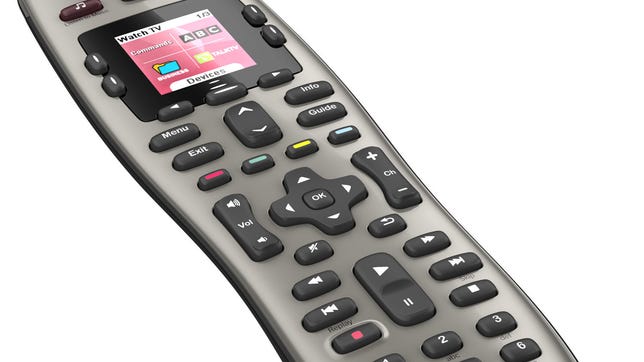

Logitech Harmony
Logitech Harmony 650/665
Logitech Harmony wrote the book on the universal remote control devices and these are the most basic clickers I can recommend for a smart home. The main appeal over a cheaper, non-Harmony-based smart remote controller, or the device that comes with your set-top boxes, is the activity-based control. Press the “Watch TV” to use as a TV remote or “Listen to Music” buttons and the Logitech Harmony remote controller turns on all the relevant devices (such as your smart TV, blu-ray player, and AV receiver), switches to the right inputs and maps the keys to that activity: Volume to the receiver and Channel up-down to the box, for example.
Unlike more expensive Logitech Harmony options, which use a universal remote control app on your phone for setup and control, you’ll have to use Harmony’s Mac- or PC-based software to program the remote (needless to say, a remote app is more convenient). The 650 and 665 also rely on IR (infrared) codes emitted from the front of the device — if you want point-anywhere convenience, you’ll have to spend up for a system with a hub.
The 665 is the only smart remote currently listed on Harmony’s site but the 650 is identical (aside from color and number of devices each can control) and can often be found for less, especially refurbished.
Read our Logitech Harmony 650 review.
$279 at Amazon$11 at Walmart.comGet Price AlertsYou’re receiving price alerts for Logitech Harmony 650/665


Sarah Tew/CNET
Caavo Control Center
Caavo’s Control Center is one of two non-Harmony smart remotes on this list and is also the second-cheapest device at $59, but there’s a catch. To get Caavo’s advanced features, you’ll need to shell out for the service fee. It costs $4 a month, $40 a year or $160 for the lifetime of the remote.
Unlike Harmony, Caavo Control Center includes an HDMI switch in addition to the smart remote. You plug your stuff into the switch and it handles the rest, including automatically recognizing your gear during setup. Caavo has its own smart voice control system and onscreen display to help you find stuff to watch on your streaming devices. The universal remote control device itself is simple and elegant and the remote finder is gold. Like the hub-based Harmonys below, Caavo doesn’t require line of sight (the switch acts as the hub) and the remote control will also work with a voice command from Alexa and Google Home speakers in homes with multiple devices.
Read our Caavo Control Center preview.
$200 at Caavo


Mari Benitez/CNET
Logitech Harmony Hub
The Hub is the only remote control device on this list that doesn’t actually include an actual physical remote device or buttons. Instead, you control everything using the Harmony app for smartphones (Android or iOS) — or by talking to your Amazon Alexa or Google Home speaker. The smart hub itself nestles deep in your AV cabinet, blasting out Infrared, Bluetooth and Wi Fi network signals to your equipment. This Harmony smart control is a great system if you prefer the Harmony app, but for most people, investing in a real smart device (maybe one with a smartphone app) is worth the extra few bucks.
$300 at Amazon
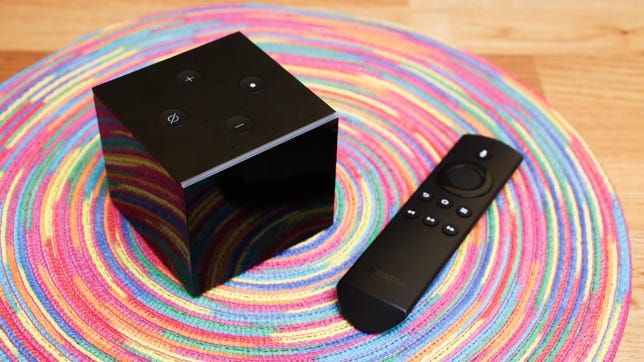

Sarah Tew/CNET
Amazon Fire TV Cube
The wacky Cube is a mashup of universal remote controls, the Fire TV 4K streamer and Amazon Echo speaker, making it the king of your smart home devices. It comes with a device but its buttons are sparse and rudimentary: real device control happens via your voice. The Cube has an IR emitter to control your gear and a mic sensitive enough to hear your commands over the blare of music. On the downside, you’ll need to keep your old remotes (even ones that aren’t smart) around for many functions.
This controlling universal remote is often sold for as little as $80 or less, so definitely wait for a sale on this device — or Prime Day — before buying it.
$120 at Amazon
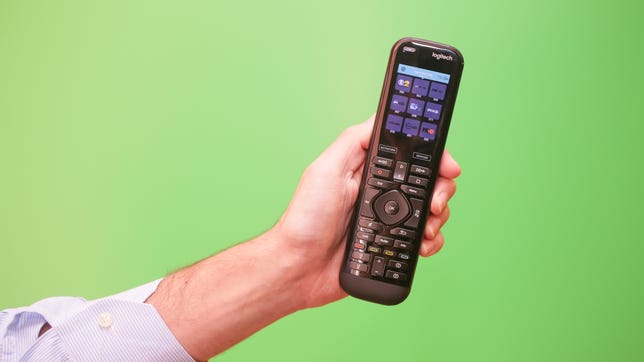

Sarah Tew/CNET
Harmony Elite (Update: Currently unavailable)
Now we’re getting into big spending universal remote control territory. The main draw of the Elite remote control over the Harmony Companion is its screen and for most users it’s just not worth it. The touch screen makes this remote control more versatile than cheaper models with buttons, especially for calling up favorite channels or the Roku app, plus the full backlighting is great. Unfortunately, the touch screen and backlighting suck a lot of battery power so you (and your family) will need to remember to park the smart remote in its dock regularly.
Read our Logitech Harmony Elite review.
$700 at Amazon
More smart home and home theater recommendations
- Budget Hack: Replace Netflix and Other Pricey Subscriptions With These Free Versions
- Best Smart Light Bulbs (Plus Switches, Light Strips, Accessories and More)
- Best Streaming Device for 2022 Roku, Apple TV, Fire Stick, Chromecast and More
- Free Movies: 10 Netflix Alternatives That Will Keep You Entertained
- Best AV Receivers for 2022
- Best Home Theater Systems for 2022
The post Best Universal Remote for 2022 first appeared on Joggingvideo.com.
]]>The post Best 55 first appeared on Joggingvideo.com.
]]>Here at CNET, we strive to give you the best advice when TV shopping, and the cardinal rule that bigger is almost always better. Not everyone has the space for an 85-inch TV, so sometimes it’s more practical to go for a smaller model. We think 55-inch TVs are a great option, as they offer a good balance of size and affordability. The best 55-inch TV for you comes down to cost per inch, as larger sets tend to be in a significantly higher price bracket.
Most modern 55-inch televisions come with plenty of features and are smart, so you can enjoy streaming your favorite shows and films on Amazon Prime Video, Hulu, Netflix, Disney Plus and more. And higher-end examples offer all the bells and whistles we’ve come to expect, including full-array local dimming, OLED screens, 120Hz refresh rate, 4K UHD resolution, high dynamic range, a plethora of HDMI ports, and even high-end gaming features — including variable refresh rate — to go with a PlayStation 5 or Xbox Series X.
The list below represents our favorite 55-inch TVs right now, and even in summer of 2022, our best TV advice is still to buy a 2021 model (some of which are in the picks below). We update this list periodically and if we haven’t reviewed the newest version yet, we include a “2022 Outlook” section to give you a sense of what you’re missing.
Read more: Do This to Your TV Now: 9 Crucial Settings to Improve the Picture


Sarah Tew/CNET
TCL 55R635
Best 55-inch TV for the money
Nov 2020
No TV we’ve ever tested offers this much picture quality for as little cash. The TCL 6-Series Dolby Vision HDR TV has an excellent image thanks to mini-LED tech and well-implemented full-array local dimming that helps it run circles around just about any other TV at this price. It’s also a solid choice for gamers, with a THX mode that combines low input lag and high contrast. As if that’s not enough, the Roku TV operating system is our hands-down favorite.
This TV first came out in 2020 but is still a current model and remains our top choice. TCL also sells an 8K version of the 6-Series, but we don’t think it’s worth the extra money, as well as a Google-powered version we have yet to review (although according to TCL its image quality is the same as this Roku version).
2022 outlook: TCL has yet to announce a successor for this TV. We’re betting it will do so later this summer.
Read our TCL 6-Series (2020 Roku TV) review.
$698 at Amazon$700 at Best BuyGet Price Alerts$700 at LenovoYou’re receiving price alerts for TCL 55R635


David Katzmaier/CNET
LG OLED55C1P
Best high-end 55-inch TV
Nov 2021
With picture quality as good as any TV we’ve ever tested and a price that’s not too crazy, the LG C1 OLED TV is still our go-to pick for people who prioritize picture and are willing to pay for it. It beats any non-OLED TV on this list, including the Samsung QN90A below, with its perfect black levels, unbeatable contrast and superb off-angle viewing. It also has the best gaming features, making it the perfect companion to an Xbox Series X or S, PlayStation 5 or both.
We also reviewed the successor to the C1, the LG C2, and the two have essentially identical picture quality. The newer version brings a couple of minor improvements, including lighter weight and a couple new gaming modes. Since the 2021 C1 currently remains on sale for hundreds less than the 2022 C2, we recommend getting the C1 instead.
Read our LG C1 series OLED TV review.
$1,330 at Amazon$1,200 at Best BuyGet Price Alerts$150 at eBayYou’re receiving price alerts for LG OLED55C1P
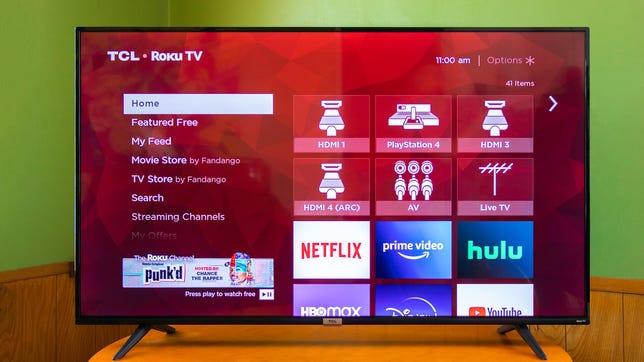

Sarah Tew/CNET
TCL 55S435
Best budget 55-inch TV
Roku is our favorite platform for live TV streaming services like Netflix, Hulu and Amazon Prime Video, and it’s even better baked into the TV. This TCL 4-Series can’t beat any of the models above on image quality — its 4K resolution and HDR performance don’t do much to help the picture — but it’s perfectly fine for most people, especially at this price.
Note that TCL also makes a Google TV and an Android TV version of the 4-Series. We haven’t reviewed them, but we expect similar picture quality to the Roku version.
2022 outlook: TCL has yet to announce a successor for this TV.
Read our TCL 4-series Roku TV (2021) review.
$650 at Amazon$419 at eBayGet Price AlertsYou’re receiving price alerts for TCL 55S435


David Katzmaier/CNET
Vizio M55Q7-J01
Best 55-inch TV for tighter budgets
The TVs above are amazing, but what if you can’t afford that level of picture quality? The Vizio MQ7 is one of the least expensive TVs to feature full-array local dimming, which lets it reproduce TV shows, movies and games with enough contrast and pop to do HDR justice. It’s a 60Hz model, not 120Hz, but it still handles variable refresh rate games for extra smoothness. If you can’t save up for the TCL 6-series, the Vizio MQ7 makes an excellent consolation prize.
2022 outlook: Vizio has yet to announce a successor for this TV.
Read our Vizio M-7 Series Quantum (2021) review.
$550 at Best BuyGet Price AlertsYou’re receiving price alerts for Vizio M55Q7-J01


Geoffrey Morrison/CNET
Vizio V555-J01
Best budget 55-inch TV runner-up
Vizio’s V-series is our favorite budget alternative to the TCL 4-Series Roku TV. We liked Roku’s smart TV system better (sound familiar?), but the V-series has some advantages, including a better remote with voice and more advanced picture settings. Picture quality between the two was basically the same, so if you don’t have a preference, it makes sense to get the cheapest one.
2022 outlook: Vizio has yet to announce a successor for this TV.
$370 at Best Buy
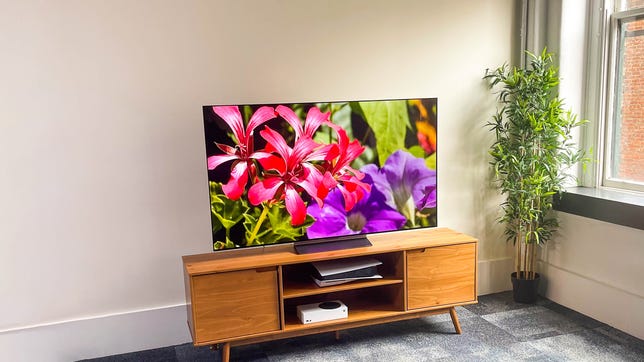

David Katzmaier/CNET
LG OLED55C2P
Best high-end 55-inch 2022 TV (so far)
The C2 is the first 2022 TV we’ve reviewed and it’s superb, but right now the 2021 model is a better deal. We compared the C2 directly with last year’s C1, side by side. In terms of picture quality, the two were basically identical, despite the fact that LG touts the new “Evo” panel on the C2. Real improvements include carbon-fiber construction for lighter weight — the 55-inch version weighs just 32 pounds with its stand, versus 51 pounds for the 55-inch C1 — as well as some additional tweaks to game mode and a new “always on” feature. Those enhancements aren’t worth the price difference, so our advice is to buy a C1 now or wait until later this year, when the C1 sells out and the C2 gets a price cut.
Read our LG C2 series OLED TV review..
$1,500 at Target$1,495 at AmazonGet Price Alerts$1,500 at Best BuyYou’re receiving price alerts for LG OLED55C2P


David Katzmaier/CNET
Samsung QN55QN90A
Best 55-inch OLED alternative
Looking for a high-end TV with spectacular image quality, but don’t want an OLED? The Samsung QN90A is your best bet. This TV uses QLED TV tech augmented by mini-LED for a brighter image than any OLED TV. The spectacular contrast of OLED still won out in my side-by-side tests, but the QN90A QLED screen comes closer than ever.
2022 outlook: The 2022 version of the Samsung QN90A is called the QN90B. We haven’t reviewed it yet, but we expect it to have very similar image quality. Samsung touts improved processing and a few extra features but nothing earth-shattering, and the 2022 QN90B currently costs hundreds of dollars more than the 2021 QN90A.
$1,398 at Amazon
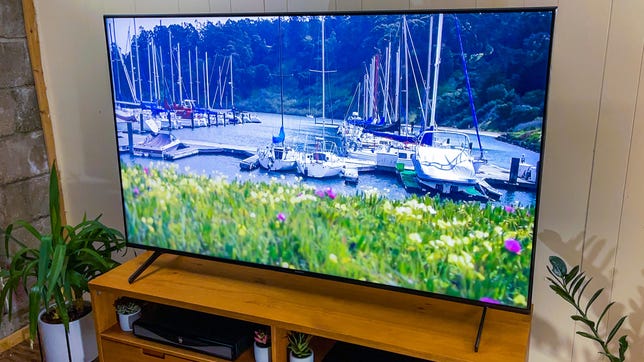

David Katzmaier/CNET
Sony XR55X90J
Best midpriced 55-inch alternative to TCL, Vizio
With excellent picture quality, anchored by full-array local dimming and plenty of brightness to make HDR content shine, the X90J is Sony’s answer to the TCL 6-Series and step-up Vizio models. This LED TV’s sleek looks and the Google TV operating system score additional points, as does its next-gen console support — including variable refresh rate (VRR), enabled by a software update in March 2022 — and built-in NextGen TV tuner. This Sony TV is perfect for PS5 gaming and works with Alexa & Google Assistant. If you want an “S” brand, this is one of the best values we’ve tested.
2022 outlook: The successor to the X90J is the X90K. We haven’t reviewed the new model yet but its image quality specifications are largely similar to the 2021 version, so we don’t expect many picture quality differences. Unlike the 2021 version, the new model ships with VRR enabled out of the box.
Read our Sony X90J series (2021) review.
$1,235 at Best Buy$1,235 at WalmartGet Price Alerts$780 at AmazonYou’re receiving price alerts for Sony XR55X90J


James Martin/CNET
Samsung Q60B
Best design in a midprice TV
Samsung is the brand that sells more TVs than anyone, and one of its most popular is the Q60 series. Its sleek QLED screen design stands out compared with the other TVs on this list — even though the ultrathin OLED models are sleeker — and it offers better features, image quality and more sizes than models like the TCL 4-Series and Sony X80K. The TVs listed in this article are all superior values, but if you want a Samsung TV and can’t afford the QN90A, this is a great choice.
Note that the 2021 version, the Q60A, is still on sale and can be cheaper than the Q60B. The newer version measured brighter in our tests, but if you want the best deal, stick with the Q60A if it’s still available.
$700 at Best Buy$698 at CrutchfieldGet Price Alerts$698 at AmazonYou’re receiving price alerts for Samsung Q60B


David Katzmaier/CNET
Hisense 55U8G
Best 55-inch TV for maximum brightness
Most of the TVs on this list are bright enough for just about any room, but maybe you want a screen that’s as bright as possible. The U8G outshines others in its price range and was basically as bright as the significantly more expensive Samsung QN90A. Its image quality falls a bit short in other areas but if raw brightness is what you crave, the U8G delivers.
2022 outlook: The successor to the Hisense U8G is the U8H, shipping later this summer. The new version uses a mini-LED backlight and could improve the image quality of the 2021 model, but we haven’t reviewed it yet so we can’t say for sure. Unlike the 2021 U8G, the 2022 U8H includes an ATSC 3.0 tuner.
Read our Hisense U8G series review.
$700 at Amazon$713 at Best BuyGet Price AlertsYou’re receiving price alerts for Hisense 55U8G
Other TVs we’ve tested
Sony KD-X80K series: Sony is a prominent brand and its higher-end TVs like the X90J do well in reviews, but the entry-level TV in its 2022 lineup, the X80K, didn’t make the list. It costs around the same as the TCL 6-Series and Samsung Q60 TVs, and had a worse picture than both, with lighter black levels and contrast. It’s definitely not a bad TV, and we liked its Google smart TV system, color accuracy and connectivity, but you can definitely do better for the money. Read our Sony KD-X80K series review.
Toshiba Amazon Fire TV C350 series: One of many Fire TVs available for sale, this one is typical of the breed: so-so image quality and a smart TV system that lags behind Roku and Google TV. If you’re a big fan of Alexa voice or see this TV at a really low price it might be worthwhile, but otherwise go for the TCL 4-Series. Read our Toshiba Amazon Fire TV C350 series review.
LG OLED G1 series: The G1 is an excellent overall TV, but compared to the C1 and C2, we don’t think it’s worth the extra money. Image quality is basically the same as those two models, so you just end up paying extra for its ultrathin, wall-hugging “gallery” design. On the other hand if that price difference is small enough — sometimes a G1 will cost only $100 more than a C1, for example — it might be worthwhile for you. Note that this TV’s successor, the 2022 LG G2, promises a brighter picture, but we haven’t reviewed it yet so we can’t say for sure. Read our LG OLED G1 series review.
How does CNET test TVs?
Our TV reviews follow a rigorous, unbiased evaluation process honed over nearly two decades of TV reviews. Our primary TV test lab has specialized equipment for measuring light and color, including a Konica Minolta CS-2000 spectroradiometer, a Murideo Sig-G 4K HDR signal generator and an AVPro Connect 8×8 4K HDR distribution matrix. We use Portrait Displays CalMan Ultimate software to evaluate and calibrate every TV we review. In every CNET TV review, three or more similar TVs are compared side-by-side in various lighting conditions with different content, including movies, TV shows and games, across a variety of test categories, from color to video processing to gaming to HDR. Our reviews also account for design, features, smart TV performance, HDMI input and gaming compatibility and more.
Read more: How We Test TVs
55-inch TV FAQs
Is a 55-inch TV big enough?
It depends on your room size, seating distance and personal taste. For a standard master bedroom or smaller living room a 55-inch TV is fine, but for larger rooms we recommend a larger TV, say a 65- or even 75-inch model, if you can afford it. If you sit closer to the screen you don’t need as large a TV for the best experience. For maximum theatrical impact, according to THX and SMPTE, you should be between 5.5 and 7 feet from a 55-inch screen, which is relatively close. Nearly every 55-inch TV has 4K resolution, and if you have 20/20 vision you can sit as close as about 4 feet and still not discern individual pixels.
How wide is a 55-inch TV?
Most 55-inch TVs measure between 48 and 49 inches wide. Because the frames around newer TV screens are typically quite narrow, 55-inch TV widths don’t vary much. Models with very slim frames are on the lower end — the 55-inch LG G1 measures 48.2 inches wide for example, while the slightly thicker-framed 55-inch TCL 4-Series is 48.7 inches wide. If you’re not planning to wall-mount the TV, you generally want the piece of furniture supporting the TV to measure at least as wide as the TV itself, and preferably a few inches wider. Refer to the manufacturer’s website for exact dimensions of a particular 55-inch TV.
How much does a 55-inch TV weigh?
A 55-inch TV weighs between 25 and 50 pounds with its stand, but this varies significantly depending on the type of TV. The TCL 4-Series 55-inch TV weighs 24.9 pounds with stand, for example, while the LG C1 weighs twice as much at 50.7 pounds with stand. Removing the stand — which often consists of a pair of little legs under the panel — allows you to wall-mount the TV and reduces its weight slightly (stands weigh between 1 and 8 pounds). Shipping weight (box, accessories, etc.) of 55-inch TVs ranges from 35 to 63 pounds. Refer to the manufacturer’s website for exact weights of a particular 55-inch TV.
More home entertainment recommendations
- Buying a New TV in 2022
- Best Soundbars for 2022
- Best Streaming Device in 2022
- Best TV Antennas for Cord Cutters, Starting at Just $10
- Dolby Atmos: Why It’s Cool, How It Works and How to Get It
- Best Sonos Speakers for 2022
- QLED vs. OLED: Which TV Tech Should You Buy?
- HDR Formats like Dolby Vision, HDR10, Technicolor and HLG Explained
- Best TVs for Gaming
- Best 75-Inch TVs for 2022
The post Best 55 first appeared on Joggingvideo.com.
]]>The post QLED vs. OLED TVs: Which TV Technology Is Better in 2022? first appeared on Joggingvideo.com.
]]>What’s happening
Two fundamentally different TV technologies, QLED and OLED, have similar names.
Why it matters
If you’re buying a new TV, you’ll want to know the differences between each one.
What it means for you
In our side-by-side reviews, OLED has beaten QLED every time. But that’s not the whole story.
In 2022, buying a new TV is just as confusing as ever. The best TVs advertise numerous confusing features like HDR, Ultra HD 4K, 120Hz and HDMI 2.1, which make it difficult to figure out what’s actually worthwhile. Two of the biggest TV terms you’ll see are QLED and OLED. They’re only one letter apart, but the technologies they describe are very different.
For the last few years, Samsung has been branding its TVs “QLED.” Its 2022 QLED lineup includes Neo QLED models in 4K and 8K resolution, The Frame art TV, Serif and the Sero rotating TV all bearing the ubiquitous Q. And Samsung isn’t the only one. TCL also makes QLED TVs, including the CNET Editors’ Choice 6-Series.
On the other side of the fence are OLED TVs. In the last few years LG has dominated the OLED market and its 2022 OLED TV lineup is more extensive than ever, but Sony and Vizio also make OLED TVs in the US. And adding to the confusion, Samsung has an OLED TV of its own in 2022, so it will sell both OLED and QLED TVs this year.
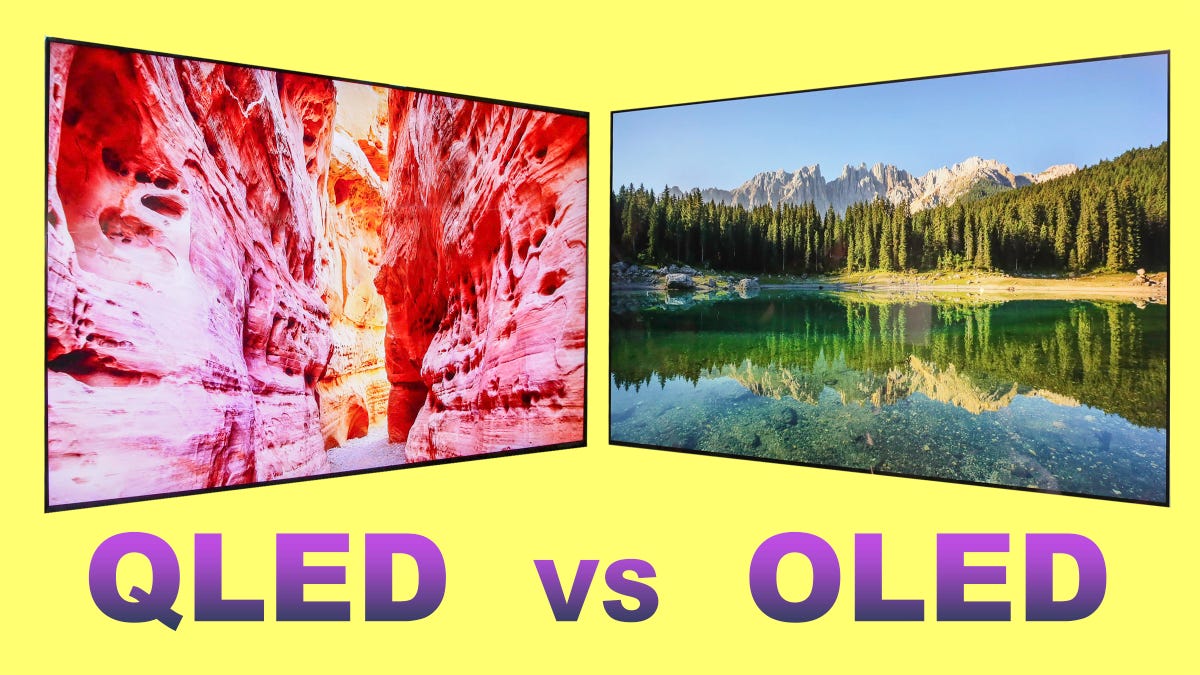
Sarah Tew/CNET
So what’s the difference between OLED and QLED? We’ll start with picture quality. In our side-by-side comparison reviews, OLED beats QLED every time. We recently compared our Editors’ Choice OLED TV — the LG C1 series — against the best 2022 Samsung 4K QLED TV, the Samsung QN90B series. The Samsung QLED came closer than ever to the LG OLED, but the LG still won. We also pitted a TCL 8K QLED TV against the 2022 LG OLED C2. Again, the OLED TV won.
LG OLED C2 (65-inch)
$2,300 at Target
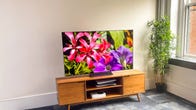
Samsung QLED QN90B (65-inch)
$1,900 at Samsung
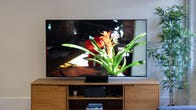
We expect OLED TVs to continue to outperform QLED TVs. Here’s why.


Now playing:
Watch this:
Sony QD-OLED Eyes-On: Early Look at (Maybe) the Best…
8:08
QLED vs. OLED: Quick summary of the TV technologies
Let’s start with a quick breakdown.
- OLED stands for “organic light-emitting diode.”
- QLED (according to Samsung) stands for “quantum dot LED TV.”
- OLED is a fundamentally different technology from LCD, the major type of TV.
- QLED is a variation of LED LCD, adding a quantum dot film to the LCD “sandwich.”
- OLED is “emissive,” meaning the pixels emit their own light.
- QLED, like LCD, is “transmissive” in its current form and relies on an LED backlight.
A QLED TV is just an LCD TV with quantum dots
The main takeaway is that QLED is closer to regular old LCD than it is to OLED, which I (and most other experts) consider a distinctly different class of television, much like plasma before it.


Now playing:
Watch this:
What is quantum dot?
2:46
Quantum dots are microscopic molecules that, when hit by light, emit their own differently colored light. In QLED TVs, the dots are contained in a film, and the light that hits them is provided by an LED backlight. That light then travels through a few other layers inside the TV, including a liquid crystal (LCD) layer, to create the picture. The light from the LED source is transmitted through the layers to the screen’s surface, which is why we say it’s “transmissive.”
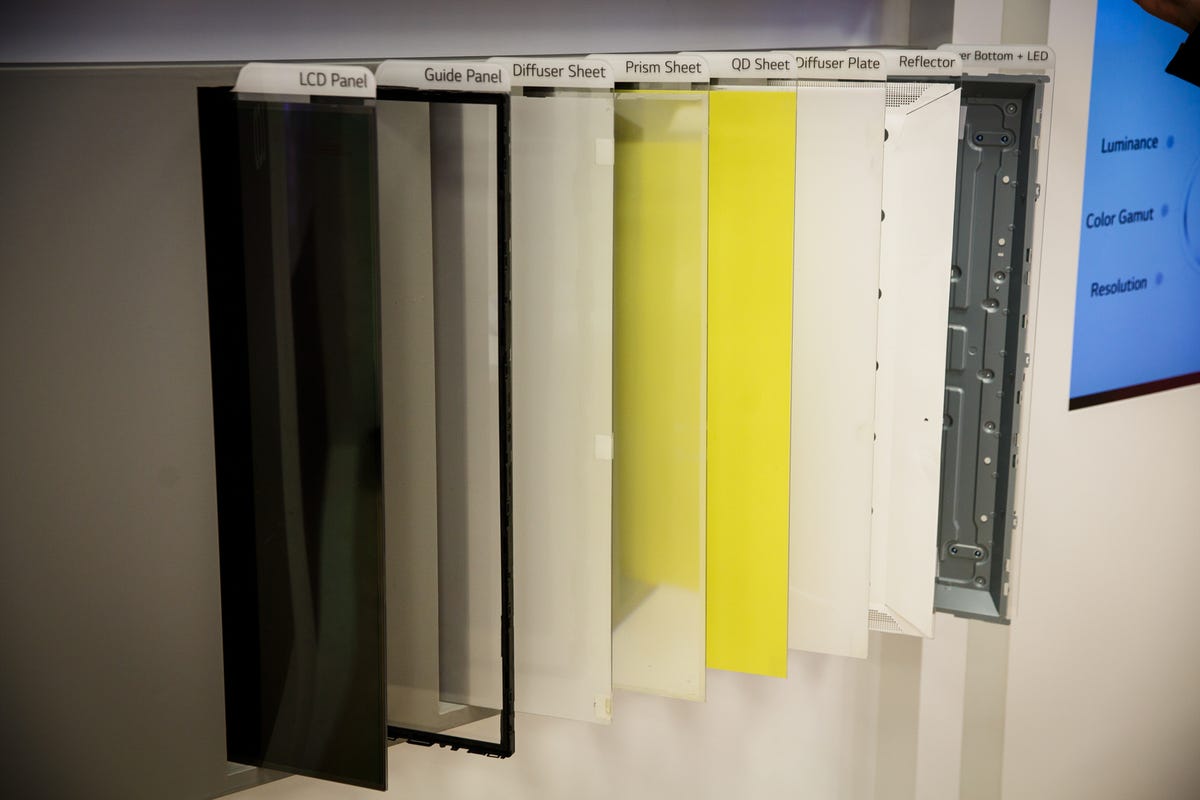

A look at the “sandwich” of layers in an LCD TV, where an LED backlight shines through a quantum dot layer (among others) and on to the LCD panel itself.
Josh Miller/CNET
Samsung has been using quantum dots to augment its LCD TVs since 2015 and debuted the QLED TV branding in 2017. Samsung says those quantum dots have evolved over time — that color and light output have improved, for example. In my experience, however, improvements caused by better quantum dots are much less evident than those caused by other image quality factors (see below).
Other TV makers also use quantum dots in LCD TVs, including Vizio and Hisense, but don’t call those sets QLED TVs.
An OLED TV is not an LCD TV at all
LCD is the dominant technology in flat-panel TVs and has been for a long time. It’s cheaper than OLED, especially in larger sizes, and numerous panel-makers can manufacture it.
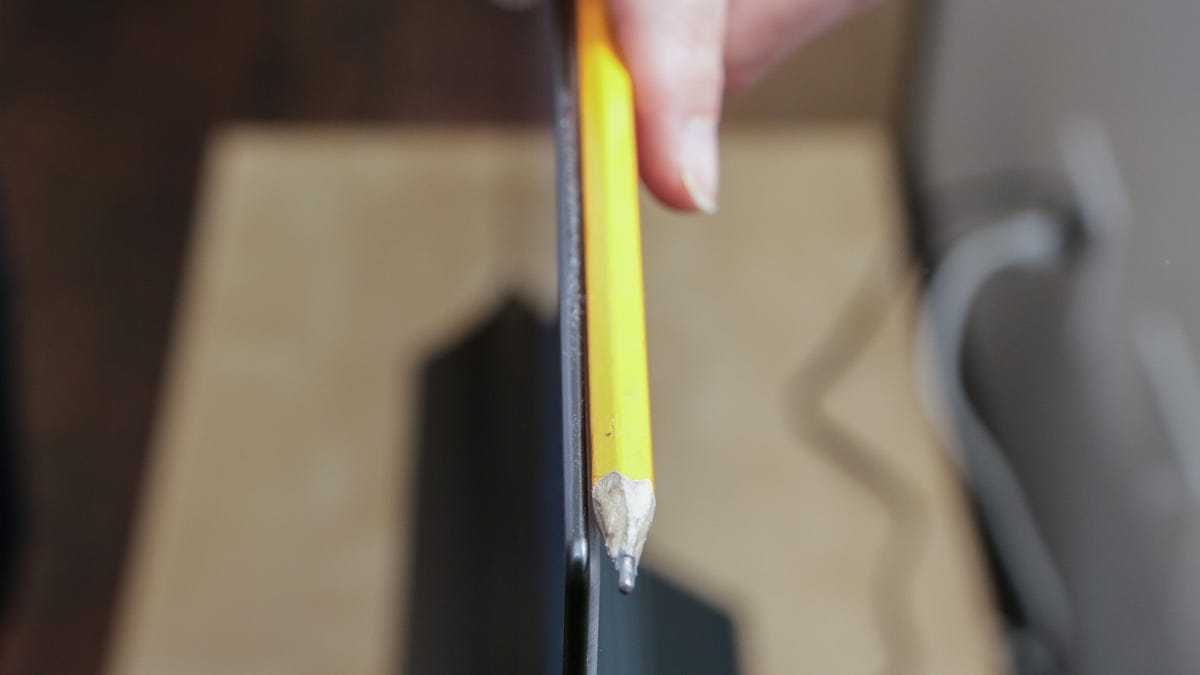

OLED TVs don’t need LED backlights so, in addition to image quality benefits, they can get amazingly thin.
Sarah Tew/CNET
OLED is different because it doesn’t use an LED backlight to produce light. Instead, light is produced by millions of individual OLED subpixels. The pixels themselves — tiny dots that compose the image — emit light, which is why it’s called an “emissive” display technology. That difference leads to all kinds of picture quality effects, some of which favor LCD (and QLED), but most of which favor OLED.
Aside from the US brands mentioned above, Panasonic, Philips, Grundig and others sell OLED TVs in Europe. All OLED TVs worldwide, including those in the US, use panels manufactured by LG Display.
That’s about to change, however. Samsung and Sony will soon debut the first OLED TVs made by Samsung Display. They promise improved color and brightness compared to current OLED TVs because they use quantum dots — just like QLED TVs. Called QD-OLED or QD Display, they’re sure to be quite expensive at first, even more than standard OLED TVs, but prices will come down eventually.
Read more: QD-OLED: Everything We Know About the Newest TV Tech From Samsung and Sony
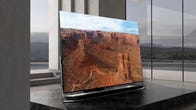

Now playing:
Watch this:
The best TVs of CES 2022 get bigger, crazier and more…
5:07
QLED vs. OLED image quality
Based on my reviews, here are some general comparisons I’ve made between the two.
QLED TV picture quality varies more than OLED
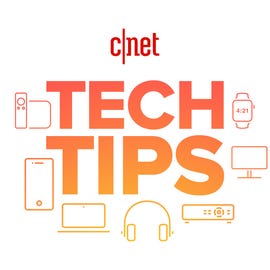

Brett Pearce/CNET
Samsung and TCL each have multiple QLED series and the most expensive ones perform a lot better than the cheaper ones. That’s mainly because the biggest improvements in the picture quality of QLED sets don’t have much to do with quantum dots. Instead they’re the result of mini-LED backlights, better full-array local dimming, bright highlights and better viewing angles, which help them outperform QLED (and non-QLED) TVs that lack those extras.
Meanwhile, every OLED TV I’ve reviewed has very similar image quality — all have earned a 10/10 in picture quality in my tests. There’s some variation among different OLED TVs, for example the LG A2 with its 60Hz panel compared to 120Hz on other OLED TVs, but they’re not nearly as significant as the differences between various QLED TV series.
OLED has better contrast and black level
One of the most important image quality factors is black level, and their emissive nature means OLED TVs can turn unused pixels off completely, for literally infinite contrast. QLED/LCD TVs, even the best ones with the most effective full-array local dimming, let some light through, leading to more washed-out, grayer black levels and blooming around bright sections.
QLED is brighter
The brightest QLED and LCD TVs can get brighter than any OLED model, which is a particular advantage in bright rooms and with HDR content. In my tests, however, OLED TVs can still get plenty bright for most rooms, and their superior contrast still allows them to deliver a better overall HDR image than any QLED/LCD TV I’ve tested.
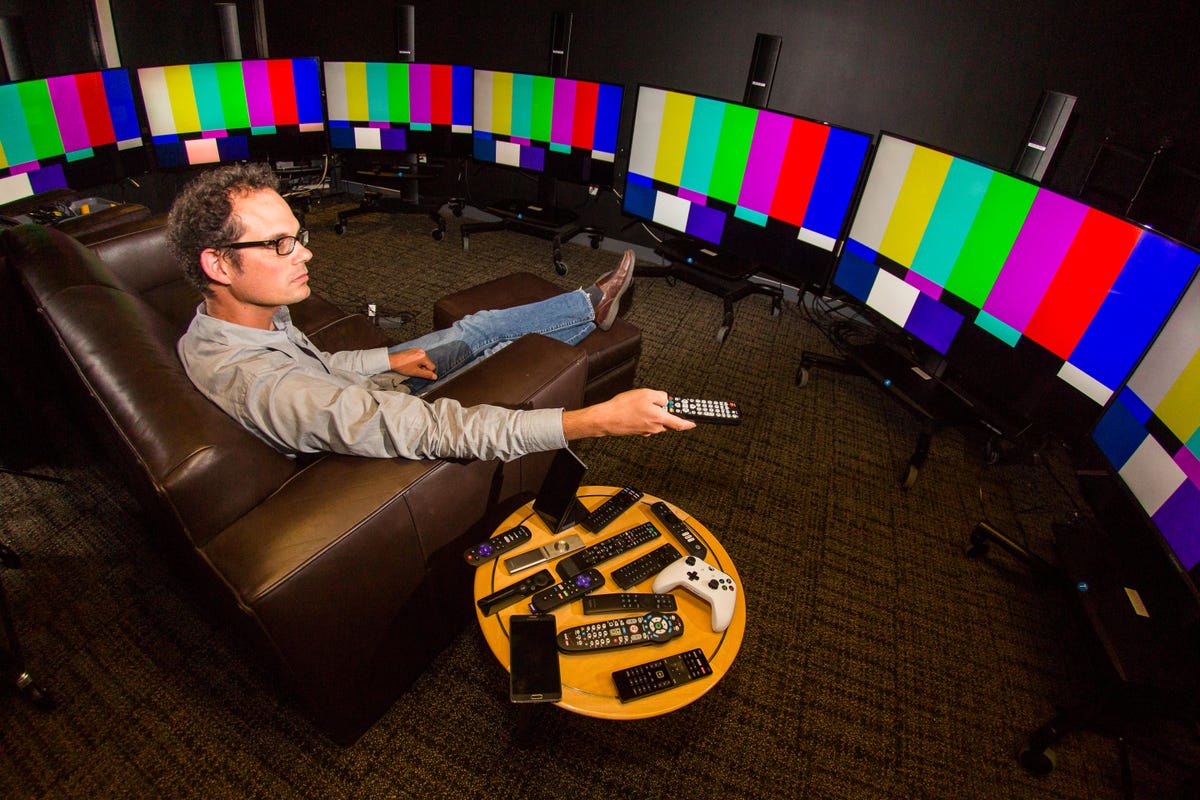

Sarah Tew/CNET
OLED has better uniformity and viewing angles
With LCD-based displays, different areas of the screen can appear brighter than others all the time, and backlight structure can also be seen in some content. Even the best LCDs also fade, lose contrast and become discolored when seen from seats other than the sweet spot directly in front of the screen. OLED TVs have almost perfectly uniform screens and maintain fidelity from all but the most extreme angles.
Resolution, color, video processing and other image quality factors are basically the same
Most QLED and OLED have the same resolution and 4K, and both can achieve 8K resolution too. Neither technology has major inherent advantages in color or video processing, although QD-OLED could deliver improved color. Check out OLED vs. LCD for more details.
QLED can get bigger and smaller (and cheaper)
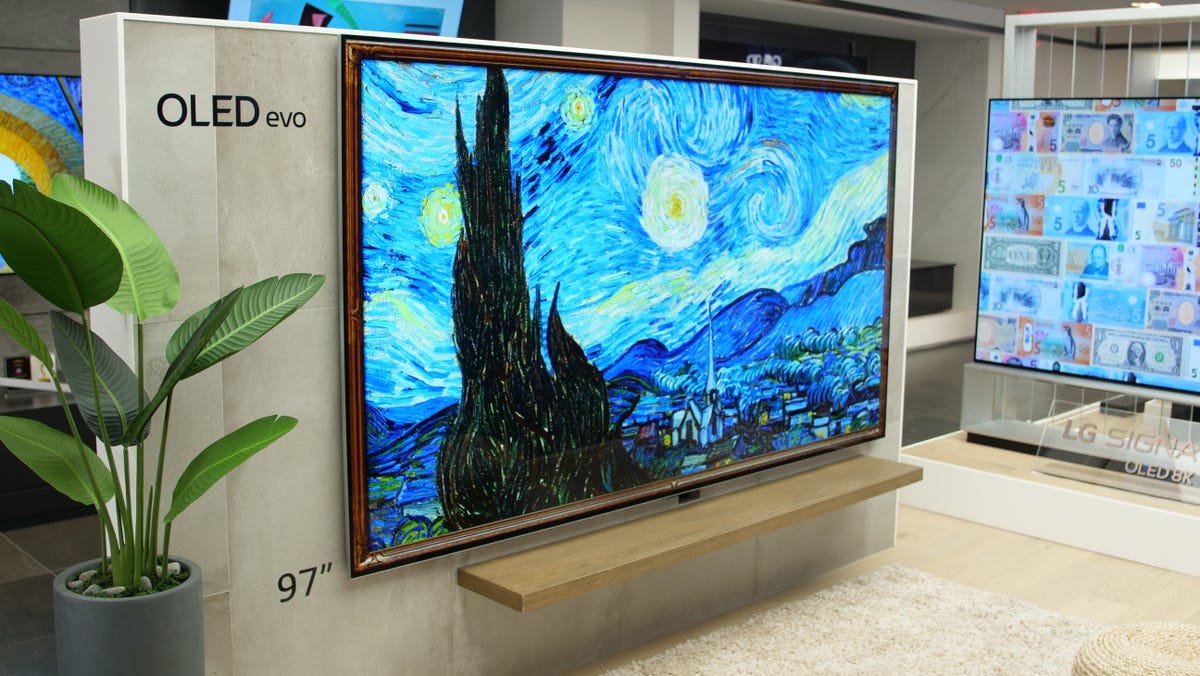

New for 2022 LG will sell the largest OLED TV yet, the 97-inch G2.
Richard Peterson/CNET
There are six sizes of OLED TV on the market today and two more sizes, 42-inch and 97-inch, are new for 2022.
OLED TV sizes
- 42-inch
- 48-inch
- 55-inch
- 65-inch
- 77-inch
- 83-inch
- 88-inch
- 97-inch
Meanwhile, as QLED TVs are LCDs they are able to be made in a greater range of sizes. Non-QLED LCD TVs can get even smaller.
QLED TV sizes
- 32-inch
- 43-inch
- 50-inch
- 55-inch
- 58-inch
- 65-inch
- 75-inch
- 82-inch
- 85-inch
- 98-inch
One big advantage, so to speak, that QLED and LCD have over OLED is the cost of mainstream sizes over 65 inches. Large televisions are the fastest-growing segment of the market and show no signs of slowing down. 77-inch OLED TVs cost $2,500 and up, significantly more than most 75-inch QLED TVs, and in larger sizes the difference is even more drastic.
What about OLED burn-in?
Burn-in happens when a persistent part of the image — navigation buttons on a phone or a channel logo, news ticker or a scoreboard on a TV, for example — remains as a ghostly background no matter what else appears on screen. All OLED screens can burn-in, and from everything I know, they’re more susceptible than LCD displays, including QLED.
All things considered, however, burn-in shouldn’t be a problem for most people. From all of the evidence we’ve seen, burn-in is typically caused by leaving a single, static image element, like a channel logo, which appears on the screen for a long time, repeatedly. That’s an issue if you keep Fox News, ESPN or MSNBC on for multiple hours every day and don’t watch enough other programming, for example. But as long as you vary what’s displayed, chances are you’ll never experience burn-in.
Check out OLED screen burn-in: What you need to know for more.
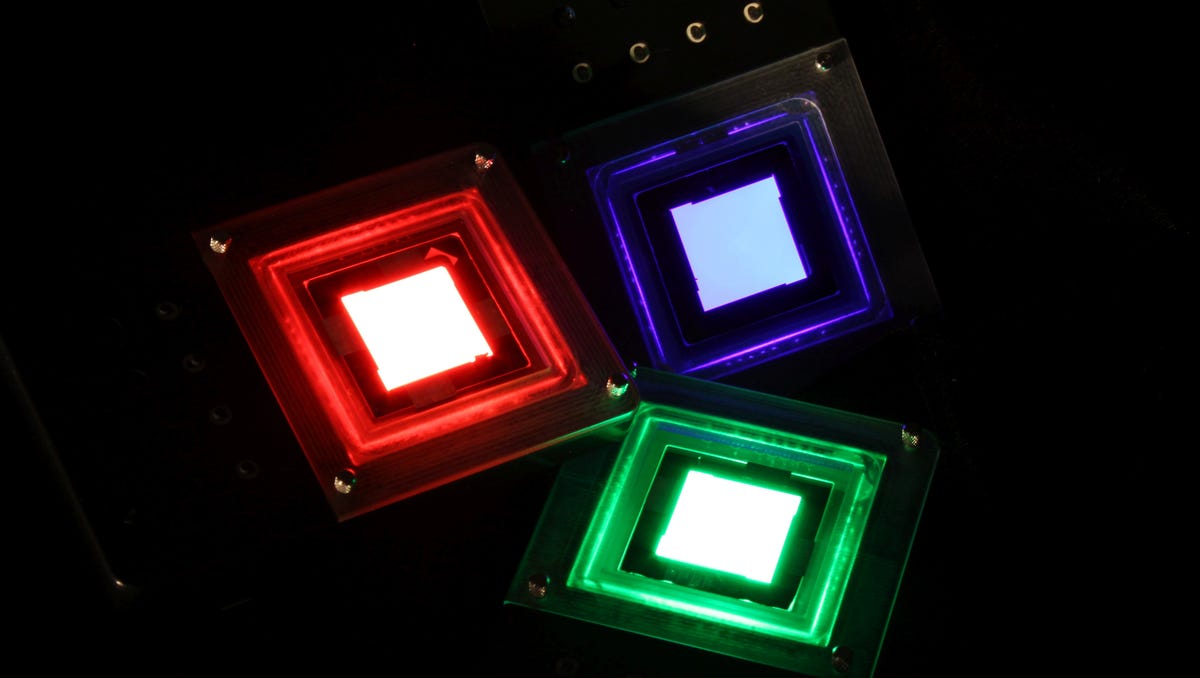

Electroluminescent quantum dot prototypes, which could pave the way for direct-view quantum dot TVs.
QDVision
Which is better in 2022 and beyond, QLED or OLED TVs?
As I mentioned above, when I pitted the best 2021 OLED against the best 2021 QLED, OLED still won — just like it has in previous years.
What about the future? Beyond its forthcoming QD-OLED TV, Samsung is researching direct-view quantum dot, which dispenses with the liquid crystal layers and uses quantum dots themselves as the light source. Emissive QLED TVs have the potential to match the absolute black levels and “infinite” contrast ratio of OLED, with better power efficiency, better color and more. That’s pretty exciting, but it’ll be a few years before we see emissive QLED TVs available for sale. Hopefully, by then they’ll think up a new acronym (EQLEDs?).
And then there’s MicroLED. It’s another emissive technology, once again spearheaded by Samsung but also sold by LG, that’s on sale now for the super rich — the largest examples cost more than $1 million. As you might guess from the name, it uses millions of teeny-tiny LEDs as pixels. MicroLED has the potential for the same perfect black levels as OLED, with no danger of burn-in. It can deliver higher brightness than any current display technology, wide-gamut color and doesn’t suffer the viewing angle and uniformity issues of LCD. It’s also friggin’ huge. It doesn’t involve quantum dots, at least not yet, but who knows what might happen when it comes to market. QDMLED, anyone?
For now, however, OLED rules the picture quality roost over QLED.
More TV advice
- New Year, New TV Tech, But Are the Claims of 2022 an Overreaction or the Real Thing?
- How to Adjust Your TV Picture Settings, No Professional, Disc or Apple TV 4K Required
- Wall-size, Million-Dollar MicroLED TVs Point to the Future of Television
- Best TV for 2022
- OLED Screen Burn-in: What You Need to Know
The post QLED vs. OLED TVs: Which TV Technology Is Better in 2022? first appeared on Joggingvideo.com.
]]>